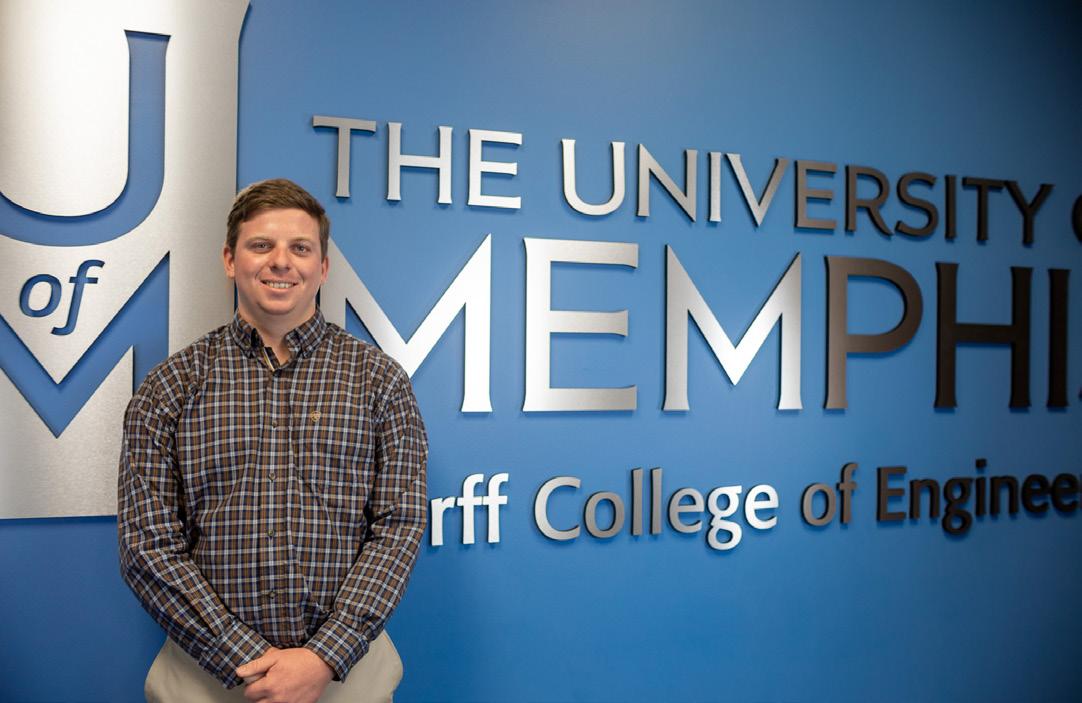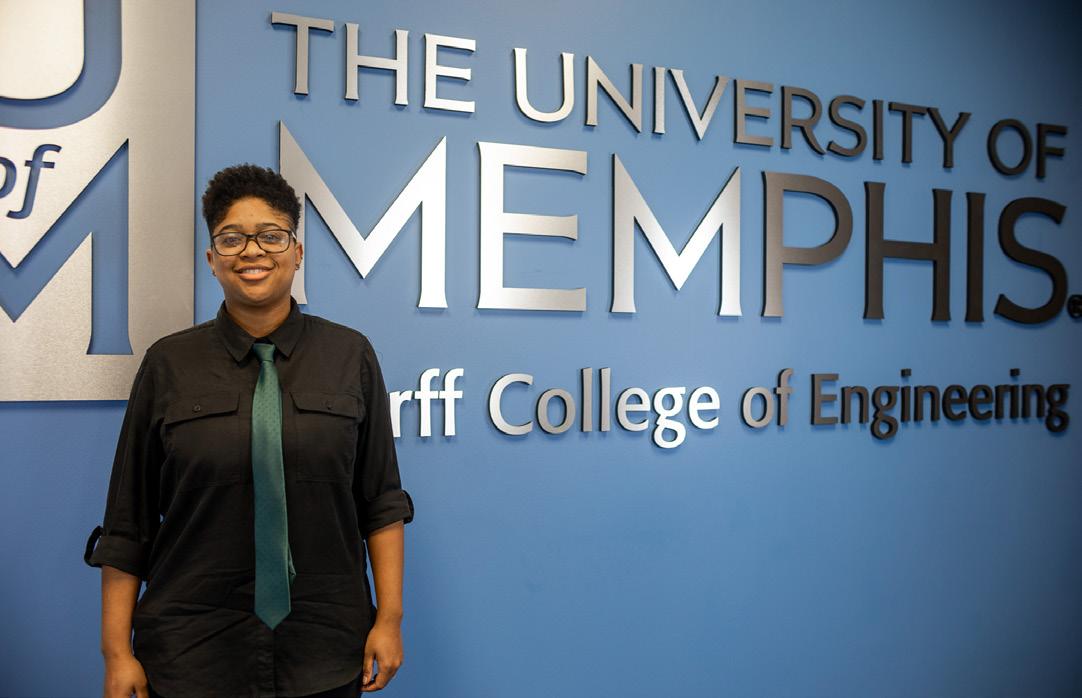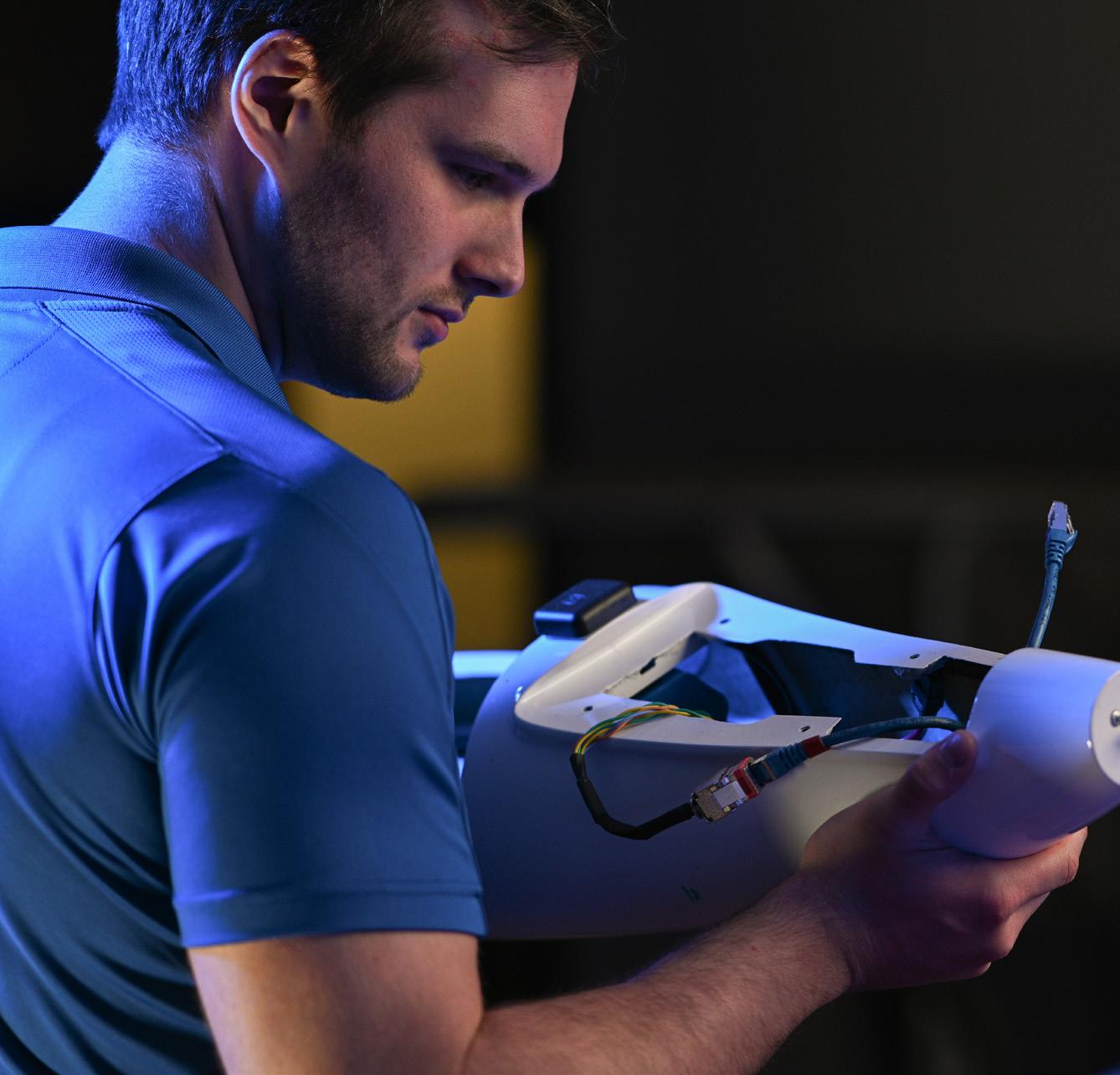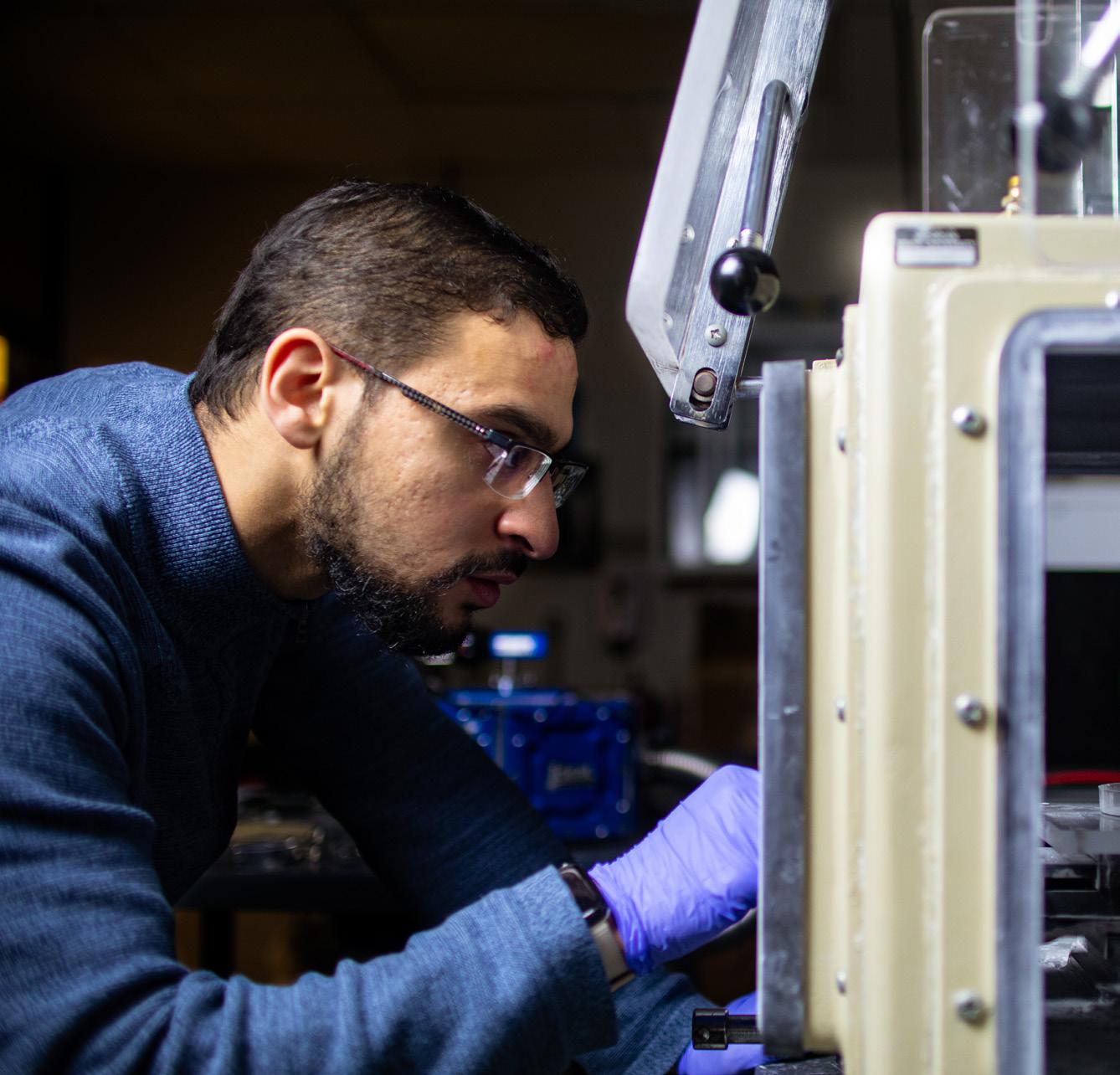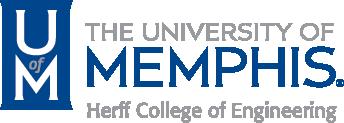

senior design expo

a message from the dean
It is an exciting time for the Herff College of Engineering! This fall we will see the opening of our new STEM Classroom & Research Building, which will enrich the already stellar education that our students receive, and coincidentally, celebrating the college’s 60th anniversary. It is appropriate that, this year, we shake things up and modify our previous senior design processes to present Herff’s very first Senior Design Expo.
The Senior Design Program is the culmination of the engineering student’s learning experience and a hallmark of success. Therefore, we want to give the achievement the attention and celebratory atmosphere it so rightly deserves. This showcase of innovative, creative, and multi-disciplinary projects that simulate real-world experiences.
Congratulations, seniors, on your achieving your capstone goal and good luck in the future!



faculty advisor
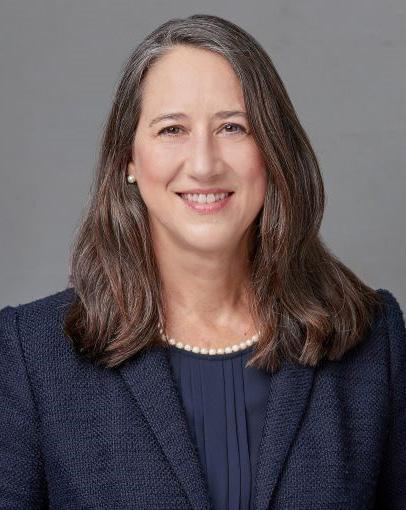
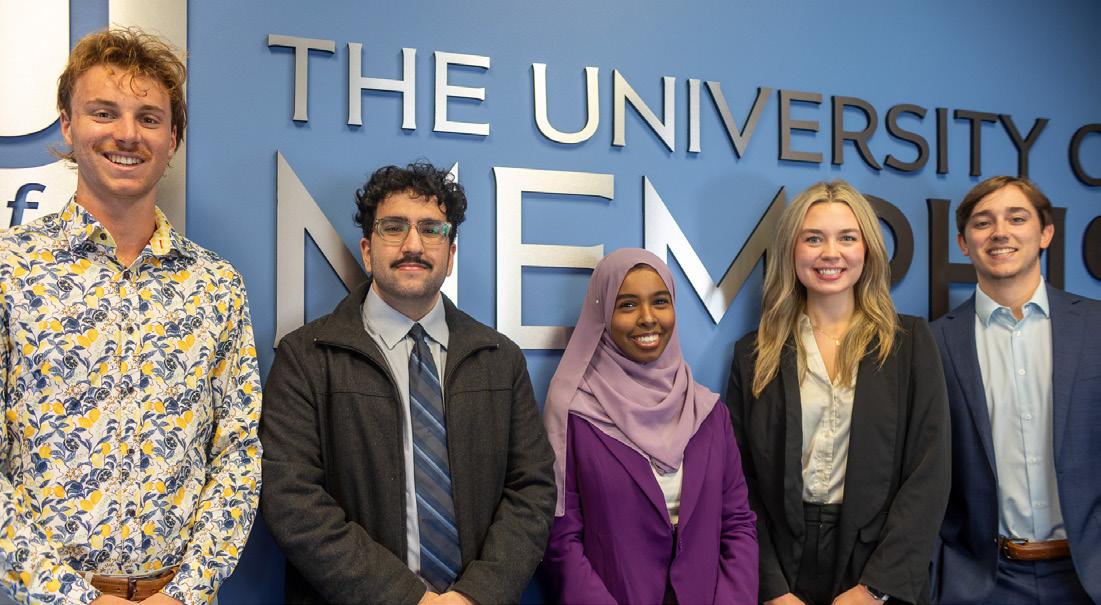
Students with cerebral palsy and other neurological, orthopedic, or developmental disorders need posterior walkers as support to improve their posture and balance to walk independently. Many of these students require a designated helper at school specifically for holding their lunch trays. Thus, to promote further independence, students need an adaptable attachment to the walker to be able to hold their lunch trays and other miscellaneous items.
We designed a bilateral clamp/arm mount attachment from readily available materials, sourced from common e-commerce and department stores (e.g., Amazon and Home Depot). Our attachment pictured below includes clamps fixated on the walker bars, connected to an adjustable arm mount, then a locking hinge and a zinc plate lined with Velcro to allow for easy attachment of a tray. The lunch tray has Velcro underneath it, which allows for easy attachment and
Team Members
Daniel Brown
Georgia Hills
Steven Go
Lara van Heerden
James Huang
Faculty Mentor
Dr. Carl Herickhoff
Client
UTHSC Otolaryngology
Head-Neck Surgery
Department
Following a rhinoplasty, nasal splints are used to ensure structural protection and proper healing of the nasal region. Current methods of conforming a nasal splint require the surgeon to form the material directly onto the patient’s nose; however, with inflammation and fragile cartilage this method can incur undesirable outcomes, such as structural damages and an extended period for healing. Surgeons need a solution that allows nasal splints to be molded without placing pressure on the patient’s nose post-surgery to minimize deviation in nasal structure and patient discomfort.
The device is comprised of three components made of acrylonitrile butadiene styrene: a nasal bridge portion and two wings with intersecting structures that are connected via steel machine screws. These wings can both increase and decrease in angle from the midline of device to account for various nasal bridge
Team Members
Vincent Chenier
Pavel Qaladize
Tibirni Yusuf
Elizabeth Scheiderer
Mason Sanders
Faculty Mentor
Dr. Amy de Jongh Curry
Client LeBonheur Children’s Hospital, Susan Anderson, PTA
Walking on a Dream
detachment. The arm mount will allow for it to be folded on both sides when not in use and to extend the mount in front of the walker when needed. The hinge allows for 90˚ rotation of the end of the arm mount, so it is perpendicular to the ground at rest and parallel to the ground when in use.
Although this is not a common issue, our project has the potential to improve the quality of life and independence of many students with a similar problem mentioned above. Our design idea may not be viable from a market standpoint to manufacture since medical insurance would not cover an attachment of this sort. Instead, we propose our design idea as a DIY product with videos provided, an instruction manual, and a list of items required to assemble it. Nonetheless, when in use, our bilateral clamp/arm mount attachment will promote independence to the students who use a posterior walker.

dimensions. The surgeon first uses this device to obtain the angle (created by the nasal structure and the sagittal plane) from the patient by securing the device flush to the nasal bridge. The devices wings can then secure this angle in place by a screw and wingnut at the intersection of the two wing structures. The surgeon can then use the inside of the device, instead of the patient, to conform the nasal splint to the patient’s specific dimensions. The nasal splint can then be removed from the device and placed on the patient’s nose.
The impact of our design lies in enhancing patient outcomes through reshaping rhinoplasty procedures. By introducing a new device that ensures precise nasal measurements and optimal comfort, we aim to elevate the standard of care in rhinoplasty procedures. Our innovation not only addresses the existing challenges in nasal splinting but also sets a new benchmark for efficiency,
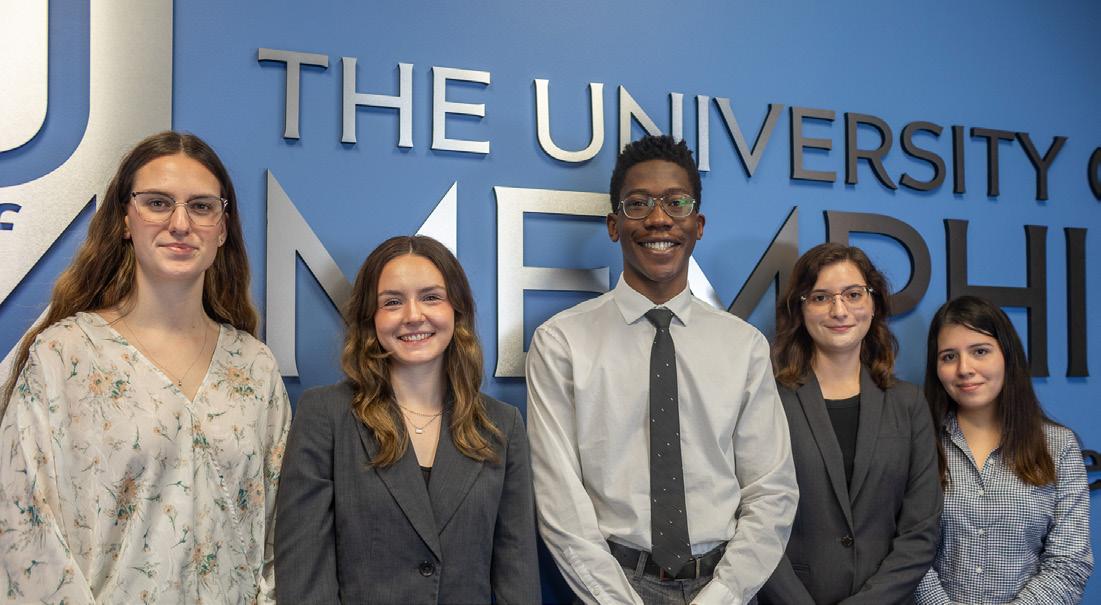
Maintaining clear vision relies on a healthy ocular surface, including the cornea and conjunctiva. Adequate tear film and eyelid function are crucial for moisture and clarity. Meibum from the meibomian glands is essential for tear health. Dysfunction in these glands often leads to dry eyes. Examining the meibomian glands requires flipping the eyelid to observe its inner surface, a process that often involves discomfort for the patient, including pulling of the eyelashes and applying pressure to the eyelid. A more comfortable method for examining the meibomian glands is necessary for better diagnosis and treatment of dry eye.
Our design features an elongated device made of polycarbonate, with a half-moon-shaped tip on both ends for application left and right eye. One-sided medical tape, slightly larger than the tip, will be affixed to the tip. The medical tape ensures a comfortable assessment for the
Team Members
Omar Ajjaoui
Laila Obadat
Nada Herzallah
Ryan Pursley
Faculty Mentor
Dr. John L. Williams
Client
Tara Buchannan, Director of Disability Resources, UofM
Shake-Me-Not
Essential tremor (ET) is a nervous system disorder that is characterized by rhythmic and oscillatory movement, most common in the upper limbs. It is widely recognized as one of the most prevalent movement disorders in the world, with an estimated 7 million patients in the United States alone. Besides its prevalence, the most significant thing about ET is that it causes some individuals difficulty in tasks requiring fine motor skills, resulting in activity limitation in 50-75% of those living with the disorder. Among those affected by essential tremor, individuals like our client exemplify the challenges posed by this disorder. His tremor not only affects his daily life but also hinders his passion for art. Individuals with essential tremors need a device to minimize the impact of their tremors while drawing and writing.
The passive vibration isolation writing implement is essentially a suspension system comprised of two pairs of springs, an outer case, and a weighted inner pen rod. By manipulating the system’s natural frequency response and reducing the frequency ratio through the
Team Members
Taylor Christian
Emma Summerhill
Toluwanimi Onafowokan
Victoria Sena
Estefania Guerrero
Faculty Mentor
Dr. Penny Asbell
Client Department of Biomedical Engineering, UofM
No Cr-eye Eyelid Evertor
patient. When applied to the eyelid, the straight edge faces the eyelashes, and the rounded part faces the forehead. Rotating the device at a 90° angle everts the eyelid. The half-moon shape can also expose the lower eyelids by placing the device beneath the eye and moving the skin downward. The device will be packed in a sterilized container. Our device, using medical-grade tape for eyelid eversion, aims to enhance patient comfort and diagnostic accuracy during meibomian gland examinations. It offers a gentle, non-invasive approach to accessing the inner eyelid surface, reducing discomfort by eliminating the need for eyelash pulling and minimizing pressure. This improvement not only enhances the patient’s experience but also allows for more comprehensive examinations, leading to better diagnosis and treatment of dry eye conditions. Ultimately, our device could revolutionize the standard of care for assessing meibomian gland function,
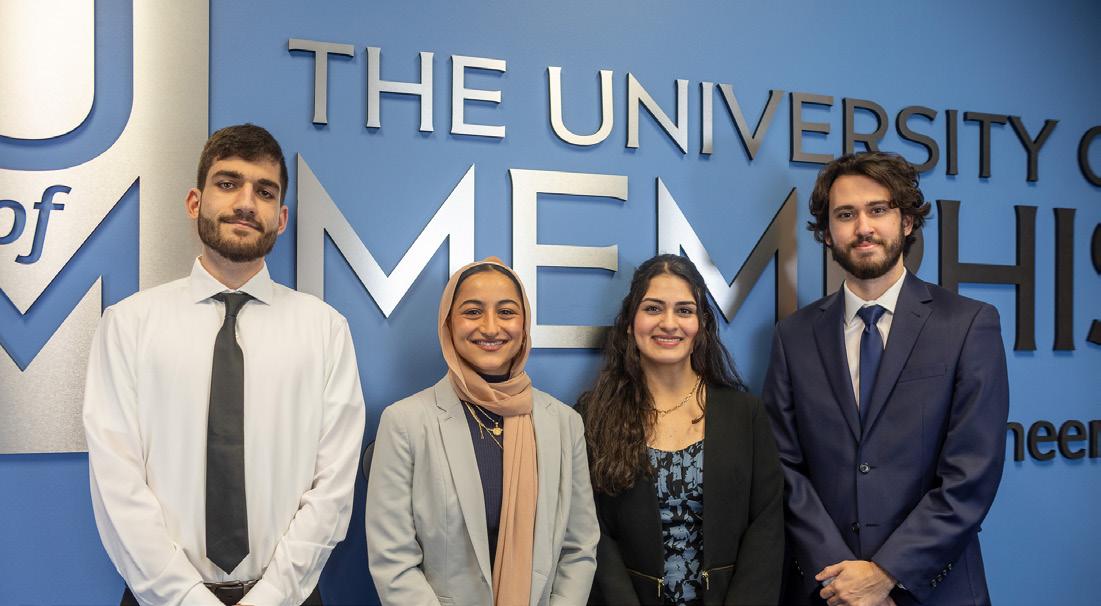
addition of springs and mass, the device reduces the transmission of tremors from the hand to the pen tip.
The reduction in tremor transmission enables more legible writing and drawing for individuals living with essential tremor, granting them more control over these fine motor tasks. The team’s device was inspired by a paper written by Dr. Akihiko Kumagai from California State University.
This tremor assistive device aims to foster independence among individuals with essential tremor by enhancing their control over tasks requiring fine motor skills. By mitigating the challenges of tremors in activities such as writing and drawing, the project promotes autonomy and accomplishment. The passive vibration isolation writing implement is meeting a critical need in the market for assistive devices for tremors, by facilitating smoother writing and drawing experiences, while advancing assistive technology for neurological disorders. Ultimately, the project seeks to make meaningful contributions to the lives of individuals with ET and the
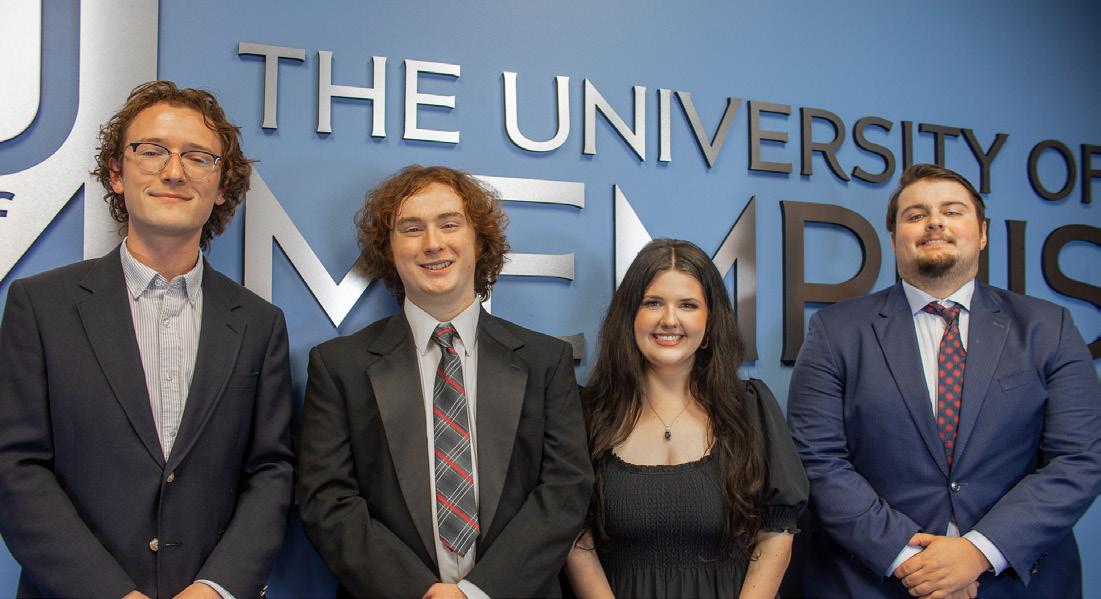
External fixators are stabilizing frames used to hold in place or adjust broken and malformed bones. Currently, the rate of pin tract infections in patients using Stryker’s Salvation II frame are as high as 90% by some metrics. These infections can lengthen the time of recovery, require the surgical replacement of pins, and in serious cases lead to osteomyelitis, amputation of the limb, or fatality. A supplementary device is needed to reduce the incidence of pin tract infections and improve patient outcomes. It has been shown that blue light has antimicrobial properties and can slow or prevent the growth of staphylococcus, the most common bacteria on the surface of the skin.
This design creates a device that uses the antimicrobial proper-
Team Members
Hannah Nicholas
Anthony Robinson
Jalyssa Smith
Dalton Reed Marniecia Steele
Faculty Mentor
Dr. Bernard Grisoni
Client
Department of Biomedical Engineering, UofM
The Urology Club
Approximately 20% of hospitalized patients have a urethral catheter at any given time, 87- 100% of which are inactive or in-bed. Bedridden patients with catheters lack access to timely urinalysis, resulting in delayed detection and treatment of health conditions, such as UTIs and yeast infections. Current methods, such as dipstick tests or laboratory analysis, are subjective or do not always provide immediate results. This gap in treatment leads to missed opportunities for early monitoring, intervention, and prevention. We designed a urinary attachment device equipped with integrated and immediate biomarker detecting capabilities. Our device is a compact cup divided into four chambers, each containing specialized gel and reagents to detect leukocytes, glucose, blood, and nitrates in urine samples. The user will pour the urine sample into the polypropylene container cup, which will funnel the urine sample into 4 separate chambers. They will then observe visual reactions, comparing them to a reference chart to interpret results
Team Members
Dylan Thompson
Jacob Mohler
Olivia Tutor
Jacob Elkins
Faculty Mentor
Dr. Joel Bumgardner
Dr. J. Amber Jennings
Client Stryker
The Pin Pals
ties of blue light to be attached to the external fixator pins or frame that will be positioned to shine blue light onto the surface of the skin at the pin site. The device consists of a simple current-splitting circuit housed in a plastic casing with a rubber-tipped clip to attach to the pin or frame. This device will be worn for 30 minutes during the patient’s cleaning routine to disinfect the area immediately surrounding the pin site.
The team anticipates this device to significantly reduce pin tract infections when used as directed by providing a new method to disinfect pin sites without harsh chemicals. This reduction would speed up the recovery process for patients with external fixators, significantly increasing their quality of life. The impact felt would
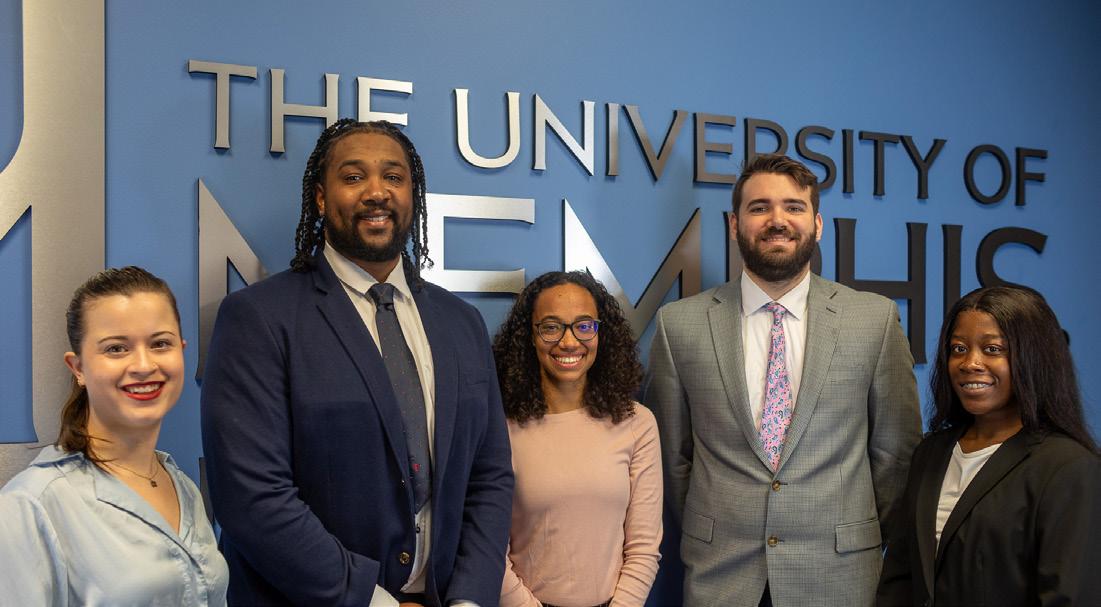
quickly and accurately, facilitating efficient urinalysis for healthcare professionals and patients. The device is user-friendly, compact, and cost-effective. It consists of 3D printed components using polylactic acid (PLA) and a polypropylene container. Moreover, it connects seamlessly to catheters and allows for urine samples to be deposited via syringe or urinary bag port, permitting collection and analysis for a wider range of healthcare facilities. Our design provides rapid analysis, enabling healthcare providers to promptly assess patients’ health status and initiate appropriate interventions.
Our project aims to improve healthcare management by providing bedridden patients with a reliable and faster urinalysis device. The integration of urinalysis capabilities into the urinary bag provides healthcare providers with timely information potentially preventing future complications. Ultimately, our design aspires to improve patient diagnosis and treatment, reduce healthcare costs,
Civil ENGINEERING
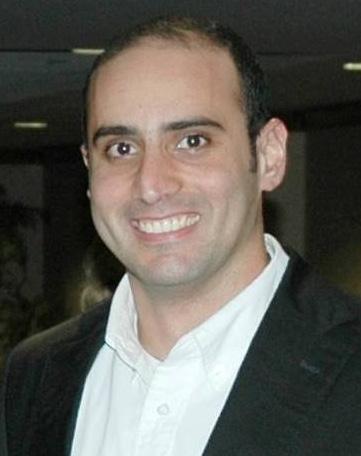

Memphis Area Transit Authority (MATA) is planning to develop a Bus Rapid Transit (BRT) system running from downtown Memphis to the University of Memphis along Union Avenue and Poplar Avenue. This project will greatly improve public transit travel times along the proposed BRT corridor. The final stop in the system is planned to be at the University of Memphis. Tiger Blue Builders has been tasked with designing an exclusive bus lane on the University of Memphis North Campus that will be used for pick-up and drop-off at the University of Memphis stop. This exclusive bus lane will be utilized by both MATA buses and The University of Memphis’s bus system, the Blue Line.
The project is a one-way, two-lane transit station between Deloach Street and Conlee Street that will include a bus shelter large enough for two buses to pick up passengers simultaneously. The bus lane will be paved with concrete due to the high loads that a city bus will apply to the pavement. A key feature of this project is a 12-inch curb reveal at the bus pick-up and drop-off zone to facilitate level boarding, which is standard for BRT projects. The entrance and exit to the bus lane were designed
Team Members
Andres Orellana
Lauren Mitchell
Rebecca Welch
Cordell Bowens
The University of Memphis has implemented a master plan program for the future growth of the university. The university’s current growth predicts a larger demand for parking in the Holiday Inn area, a garage to accommodate removal of parking/new student growth, and a safer, more channelized roadway through the current roadway system. The current design on campus is a roadway system that is not channelized and does not have clear priority of traffic markings at intersections. It also has no specified entries with landscaping to buffer entries for parking area, or areas to accommodate left turning traffic as the master plan would like. Our challenges included accommodating clients’ feedback and planning with the other master planning groups to allow our projects to align with spacing and engineering recommendations.
Team Members
Nathan Shields
Edger Ibarra
Kristofor Walicke
Malik Conrad
Jayla Morris
Jacob Hall
Tiger Blue Builders
with large enough radii to ensure the buses can comfortably make their turns. Additionally, a connection with the parking lot south of the site has been incorporated into the design to allow access for private pick-up and drop-off once passengers have exited the MATA buses.
One challenge experienced by the team was that the proposed design location provided by Campus Planning required buses to make an unsignalized turn left onto Poplar Avenue, which is highly unsafe. Tiger Blue Builders has recommended that buses instead take a right turn onto Conlee Street and proceed south to Central Avenue and make a right turn. This would make the bus route considerably safer for everyone involved.
Tiger Blue Builders has developed a set of preliminary construction plans that includes existing and proposed layouts, signing and pavement marking plans, erosion prevention and sediment control (EPSC) plans, temporary traffic control plans, and applicable construction details. Estimated quantities and a preliminary cost estimate has also been prepared for the project. In summary, Tiger Blue Builders is developing this project to provide more accessible and efficient public transit.
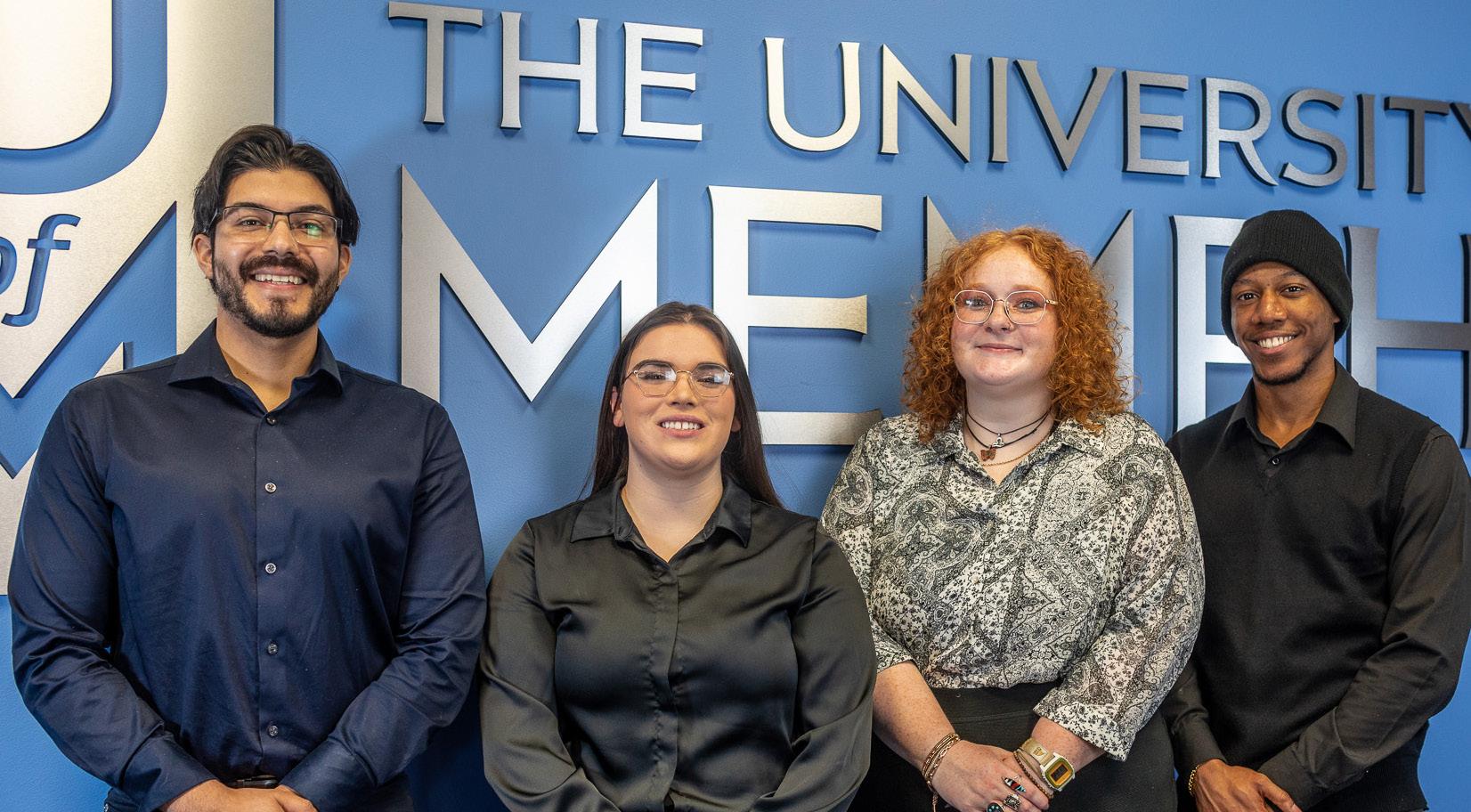
The parts that tie into the other master planning groups include drainage, pavement grading and allowing the same type of vehicular travel from the bus lane though our system. Our recommendation is a channelized roadway that allows for car and bus travel connecting the entryways of Poplar Ave., Deloach St., and Central Ave. This recommendation will also include specified entries and exits to parking areas with protected left-hand turns and landscaping buffers. It is a solution that will allow for a more efficient flow of traffic with less worries of conflict points and confusion of direction of traffic flow. Reference the figure below to better gauge potential channelization options. The final design shall include considerations for future developments.
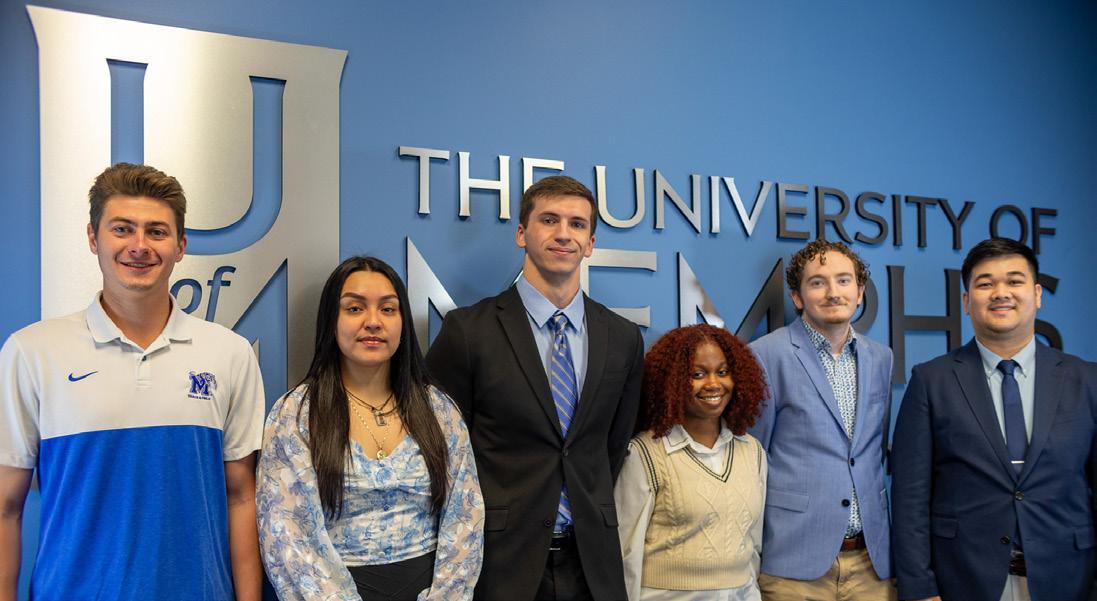
The University of Memphis has ongoing plans to expand the northern portion of its campus. The curbline along Poplar Avenue and Deloach Street, a part of this planned expansion, is currently considered unattractive and obstructs the view of the university. The University of Memphis has expressed a need to increase the aesthetic footprint along this curbline.
Currently, there is an iron fence with three detention basins along Poplar Avenue, reducing the visibility of the campus. In addition, there is a large parking lot directly south of the fence line. The parking lot is slated to be revised during the expansion. The University of Memphis Campus Planning and Design plans to remove the fence and detention basins. The existing detention basins must be replaced with a new detention basin with an increased capacity. The site currently has inlets and pipes that need to be moved and rerouted due to these changes. The proposed system cannot interfere with the planned landscaping along the
Team Members
Jeremy Waldron
Sergio Benavides
Charles Bell
Luke Guess
Aiden Grimes
Alberto Rodriguez
D1 Engineering
Throughout the last decade, the department of civil engineering has had the lowest enrollment numbers of all the different engineering disciplines offered through the Herff College of Engineering. In an effort to increase these numbers, the Department of Civil Engineering desires our senior design group to design and construct various shake table models. These models shall display the importance of structural engineering for the recruitment of future engineering students. Given the lack of parameters and guidelines the senior design group has been challenged by designing a product that will display the desired outcome, while being backed by engineering judgement and justification. Another challenge being that this project has been limited to a homebuilt shake table with inconsistent controlled accelerations rather than the computer-controlled shake table (currently out of commission) that can accu-
Team Members
Jason Doland
Julissa Tiscareno
Zachary Person
T’imra Hearns
James Terburgh
Andrew Huynh
Honey Co. Solutions
On this basis, Honey Co. Solutions proposes the addition of an underground detention basin beneath the revised northern portion of the updated parking lot. The addition of an underground detention basin relieves the area along the curbline for future development and landscaping. The design proposed utilizes the StormTrap underground detention system. New inlet locations are proposed west of the Early Learning Research Center, west of the proposed parking garage on Conlee Street, and on the northern edge of the parking lot above the proposed detention basin. All new inlets will be piped directly into the detention basin and the remaining existing inlets will be rerouted. The parking lot will be graded to account for the new inlet locations. The new detention basin will be built to accommodate a required 10-15% increase in capacity over the existing total basin capacity.

rately simulate seismic forces based on engineered design data. The proposed design was made modular with a modular base along with interchangeable bracing systems to ensure simplistic demonstrations with minimal training necessary. The design required a hierarchy of design considerations to narrow down the many options into a final design. The design specifications from the ASCE 7-16 were given priority to other parameters for emphasis on engineering applications. This was followed by an effort to entice touring students interested in engineering. The model(s) constructed shall be flexible enough to demonstrate the effects of lateral forces. This design shall visibly and clearly show the effects that structural engineering has on the world around us whether this be in our homes (residential) or places of commerce (commercial).
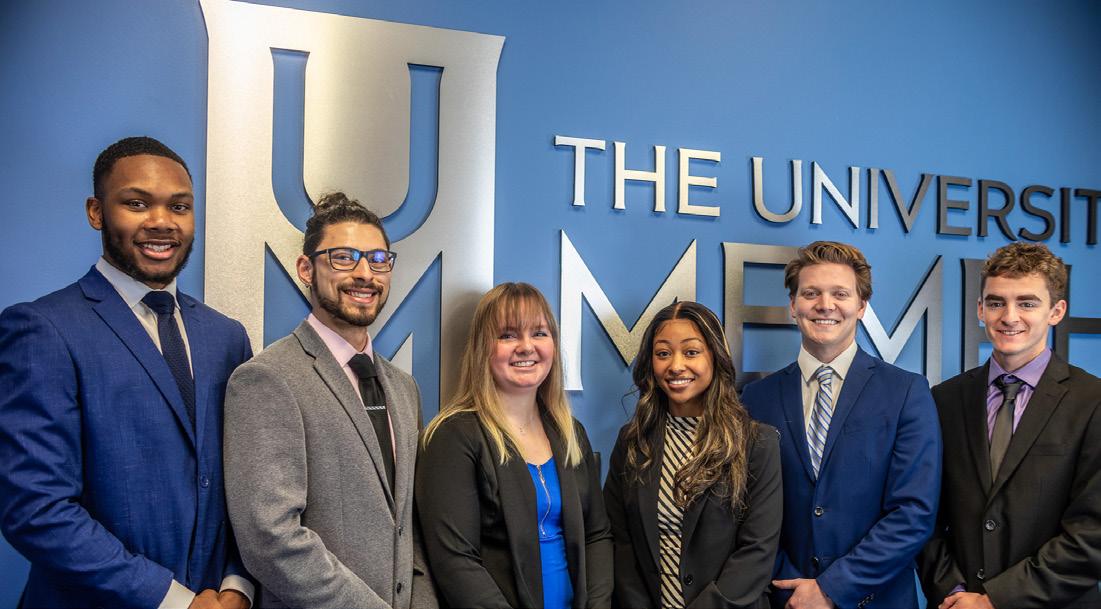
The Builder’s Express aims to design an engaging shake table model with the goal of increasing student enrollment in the Civil Engineering department. The model will consist of an adaptive framing system, a demonstration of several types of bracing and dampers, and show the effects of changing variables within the model. The team will design the model by first completing an alternative analysis to determine the design method and materials used for the fabrication of a successful and interactive model. To fulfill the scope of the project, the team will research, design, and construct the model within a budget of $1,000 for all supplies and equipment needed.
Construction of the shake table model had many challenges due to the necessary considerations taken with the intent of creating the best and most competitive model. These challenges include what kind of structure to build, choosing the best physical and material properties for the structural members and connections, navigating through appropriate code requirements to develop innovative bracing and damping systems, and understanding how to create the theoretical model within an unfamiliar computer software. Demonstrating accurate data collection without some key equipment was one of the most difficult tasks toward this project’s
Team Members
Anthony Miles
Ivan Estavanott
Alannah Criswell
Essence Pitts
Alex Robinson
Liam Walsh
The Builders Express
completion. These challenges all align with the imperfect reality of constructing a model while acquiring necessary resources and dealing with time constraints and occasional setbacks. The proposed design is a five-floor model made of aluminum with a tuned liquid damper, a pendulum, and different bracing systems that dissipate external energy within the model. The model’s base is 12 inches by 12 inches, with the height of each floor being 8 inches. The total height of the model is 40 inches. Aluminum was chosen due to its high strength, lightweight, and corrosion-resistant capabilities. Every aspect of this model has been designed with the intention of maintaining its same appearance over the next few years so that it can be reused for demonstrations. The structure will exhibit the theory of resonance and natural frequency to show the importance of the frequency verification process in real-life structures. SAP2000 was used to model the structure and the structural response through time-history analysis, and the app, Arduino SJ, was used to record the acceleration of the shake table. The final design will have multiple attachable and detachable components to show prospective students different types of structural innovations to pique their interest in Civil Engineering.
Electrical & Computer ENGINEERING

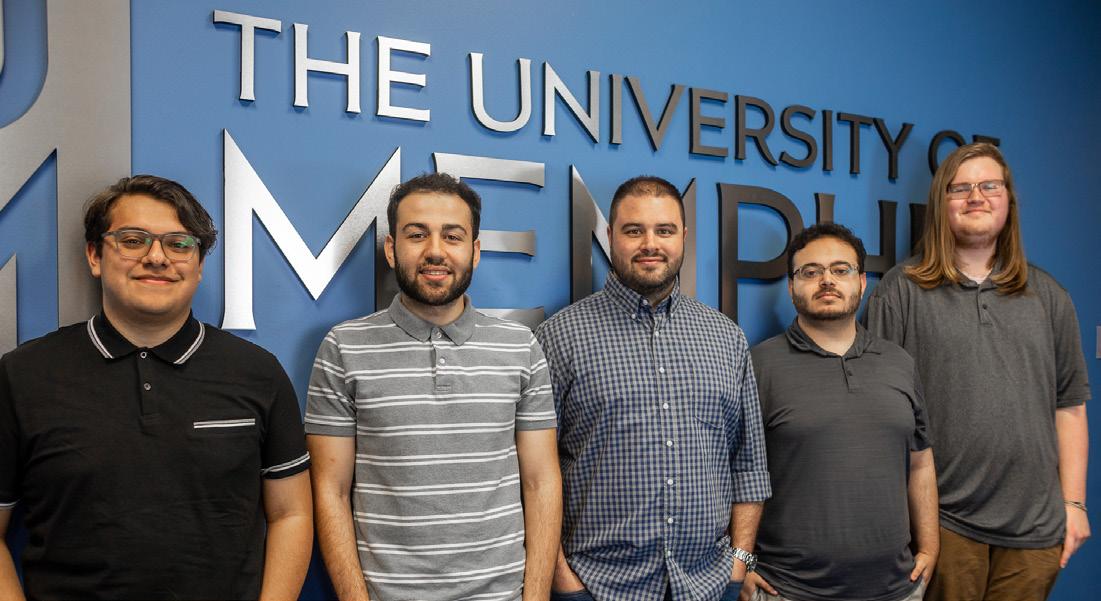
Our mission is to design a device that can visualize the location and intensity of specific audio sources using microphone arrays for capturing directional audio signals and a camera for capturing the environment. Our engineering design requirements are a) accurate localization of audio sources within ±22.5 degrees (solid angle), b) detection range between 5 and 8 meters, c) ability to detect audio signals in the range of 60 to 80 dB, d) visualization of audio source coordinate and intensity using a color-scale, and e) detection accuracy of 90%. Our design uses a microphone array for capturing multi-directional audio signals processed using a Raspberry Pi as a computational device. A signal
Team Members
Allen Tenedero
Ahmed Mohamed
Jovita Gomez
Carson Raymond Helton
Nguyen Nguyen
Faculty Mentor
Dr. Mohd Hasan Ali
Client
Dr. Mohd Hasan Ali
Team Members
Homero Ortiz
Dawoud Daoud
Kevin McKenzie
Ezzadin Alkabsh
Carter Klein
Faculty Mentor
Dr. Eddie Jacobs
Client
Dr. Eddie Jacobs
Acoustics Visualized
processing algorithm is designed to localize the signal source, determine the signal intensity and to fuse the audio information with the image of the environment captured using a camera. We anticipate that with necessary computational resources, our design will allow live display of audio information using color-coded boxes superimposed on images of the environment representing the location and intensity of the audio sources. We anticipate that our design project will be useful in situations where an audio signal’s precise location is necessary, such as for automotive repairs and localizing drones.

Wind Turbine Generators are one of the most developed and commonly used renewable energy sources that generate electrical power without emitting pollution. Nowadays, wind turbine generators face reliability issues due to power instability from disturbances such as electrical faults. These issues are improved and fixed upon the implementation of STATCOM (Static Synchronous Compensator) and SVC (Static VAR Compensator). However, these devices are very costly to implement and maintain.
Our team’s goal is to design a transient stability device that is efficient and cost-effective, requiring a minimum number of components compared to SVC and STATCOM. This device, implemented with automated artificial intelligence, controls voltage and power, and notifies users of electrical faults. The AI uses a PI (Proportional-Integral) Controller to calculate the error between the output voltage and the reference voltage by gathering data from the wind
turbine generator’s output voltage. The PI Controller is connected to the Thyristor Switch Capacitor (TSC), which acts as the voltage regulator. The TSC is activated with a firing angle at 0° (ON) and 160° (OFF), depending on the calculated error. The AI also provides notifications on the user interface in the event of an electrical fault (three-phase, twophase, and single-phase) and presents graphical voltage data over time.
Our expected results should mirror the functionality and graphical data of the simulated SVC device. It is important to note that while this device is initially scaled down to accept a maximum of 5 Volts (V), it can be quickly and linearly scaled up to meet higher voltage requirements. With its adaptability and potential for scalability, this concept device will significantly impact the economy and reliability of wind turbine generators.
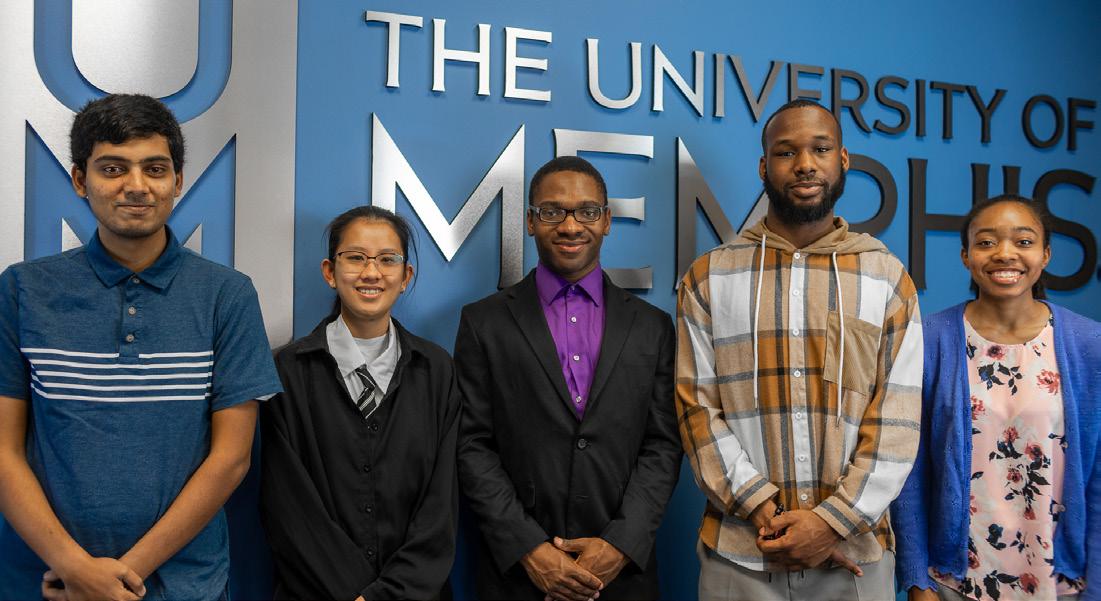
College campuses often face significant parking challenges, including limited space, high demand for parking spots, and the need to ensure that parking is available to eligible individuals. This senior design project addresses the challenge of optimizing parking management by leveraging advanced Artificial Intelligence (AI) and Machine Learning (ML) to create an Autonomous Parking Tag Detection System. The system is engineered to autonomously scan and validate parking tags, ensuring only authorized vehicles use the allocated spaces. The design encapsulates a robust AI/ ML algorithm trained on a diverse dataset of parking tag images, augmented for variations in lighting, orientation, and occlusion. It utilizes state-of-the-art neural networks for image recognition tasks, seamlessly integrating with an existing campus surveillance infrastructure. The engineering specifications require the system to achieve at least a 95% accuracy rate in recognizing valid and invalid parking tags
Team Members
Tyler Markell Woodley
Erik James Boyd
Marissia Kay Brady
Wesam Homsi
Travis Dewayne Mitchell
Faculty Mentor
Dr. Mohd Hasan
Ali
Client
Department of Electrical and Computer Engineering
Electric Avenue
As the population grows and technology continues to evolve, energy demand is expected to rise over the next few decades. Today, energy demands are met by fossil fuels and nuclear power. However, with fossil fuels being a finite resource that has a negative impact on our environment, the desire for renewable power has increased in the United States and around the world. The mid-south currently utilizes solar farms and hydroelectric plants for renewable power generation, accounting for an estimated 11% of total electricity generation. Due to the mid-south being a low average wind-speed region, traditional wind farms are not economically viable and do not contribute meaningfully to renewable power generation. There is a need for wind turbines that can operate in regions that have average
Team Members
Ibrahim Mohammad My G Danh
Jerquindal Jermerish Kelly
Godswill Chinemerem Iroh
Erin L Rodgers
Faculty Mentor
Dr. Mohammadreza Davoodi
Client
Department of Electrical and Computer Engineering
EECE GOATS
in real-time, process video feeds from surveillance cameras, and feature an intuitive user interface for ease of use by campus visitors and administrators alike. Preliminary results have demonstrated promising accuracy levels in tag detection, and ongoing iterations aim to refine the model further. Anticipated results include streamlined parking experiences, reduced congestion, and improved overall campus traffic flow. Upon successful implementation, the system is expected to significantly reduce the time spent by drivers searching for parking spots and enforce parking regulations more effectively. In conclusion, this project’s successful execution stands to elevate the campus parking infrastructure. The deployment of this system is expected to not only streamline the parking experience but also manifest as a boon for campus administration, setting a precedent for smart parking solutions in academic institutions.

wind speeds lower than 9 mph. Our proposed solution to this problem is to mechanically couple several turbines efficiently to a single generator. This design utilizes vertical axis turbine blades and will take up a minimal amount of space, to provide renewable power to low-wind regions. We expect the wind turbine system to effectively combine multiple turbine outputs at wind speeds as low as 5 mph, with a linear increase in power generation as a function of increasing wind speeds. The effectiveness of our design to operate at low wind speeds is validated by measuring the system output voltage as a function of wind speed. Using our small-scale design, we gather data to determine if the mid-south region could benefit from a larger-scale implementation of multi-turbine single-generator systems.
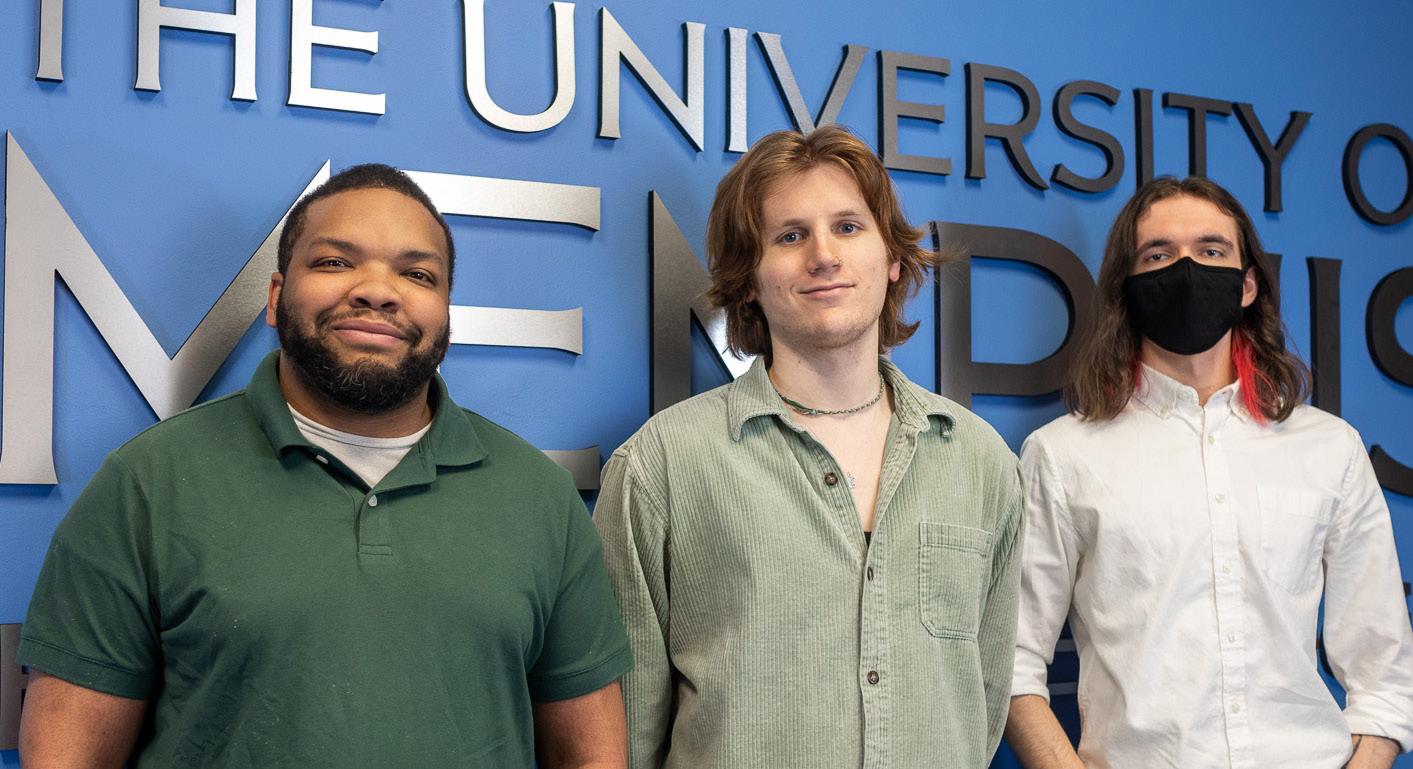
When most facets of music consumption and production transitioned to digital a few decades ago, the Musical Instrument Device Interface (MIDI) protocol became an integral tool for musicians and producers alike. MIDI facilitates intercommunication of signals between digital instruments, such as synthesizers, and the Digital Audio Workstations (DAWs) where the tracks are produced. It is crucial in the use of Virtual Studio Technologies (VST) such as amp and effect board simulators. The digital nature of MIDI lends MIDI tracks a much higher degree of malleability than audio recordings, which makes it an invaluable asset in studio settings.
The increasingly digital landscape of music production has illuminated an interesting problem in the technical music community: how can polyphonic audio signals be converted to MIDI signals? The Fourier Boyz propose the usage of Non-negative Matrix Factorization (NMF) to isolate
Team Members
Devin Luis Ceruti
Ajay Ravi Hanumaiah
Jared Andrew Hassman
Akash Purushothaman
Faculty Mentor
Dr. Aaron L Robinson
Dr. Mohammadreza Davoodi
Client
Department of Electrical and Computer Engineering
JAADE Robotics
The IEEE (Institute of Electrical and Electronics Engineers) robotics team is required to build a robot for the Hardware competition at Southeast Con 2024. Southeast Con is a yearly conference for professionals and colleges associated with IEEE to gather for networking, competitions, and gain valuable insight on the future of Electrical and Electronic engineering. The hardware competition this year focuses on building an autonomous system that can collect and deliver packages while maneuvering across difficult terrain. Engineering requirements of the robot are as follows: Must be autonomous, fit within a 1 ft cube, must be below 25 pounds, collect and deliver packages of different shapes and sizes, have no explosive materials, cross difficult terrain, and complete the designated course within 3 minutes.
Team Members
Tamarcus Kantryal Johnson
Gabriel S Pike
Cooper John Washburn
Faculty Mentor
Dr. Mohammed Yassin
Client
Department of Electrical and Computer Engineering
Fourier Boyz
the fundamental frequencies present in a polyphonic audio signal while preserving their temporal relationships to recreate the input signal as a MIDI signal (aka MIDI message).
The system will be software based with a front-end interface where the user enters the desired audio file to convert to MIDI, along with appropriate parameters: tempo, instrument type, and number of musical components/features. The transformation from audio to MIDI, accounting for file size, should be fast and accurate.
Lastly, the system should run on both MAC and Windows OS. In testing, a prototype of this software accurately detected and separated pitch information. Musical note onset and offset data is gathered using the spectral flux of each note’s time data, employing a dynamic thresholding approach to filter out insignificant data points such as overtones, undertones, sympathetic resonance, and other noise sources.

We chose to base our robot design off of an Explosive Ordinance Disposal (EOD) robot due to the precision, accuracy, and maneuverability of these systems in the real world. After brief modifications to the typical model of an EOD robot, we will be able to collect, store, and deliver the packages of varying shapes and sizes all within 3 minutes on the designated course prescribed by the IEEE. We have created a robot that can successfully move through difficult terrain, autonomously detect the packages it was designed to collect, and deliver these packages into designated zones based off color. Our robot design has the potential to change how packages are delivered around the country.
Mechanical ENGINEERING
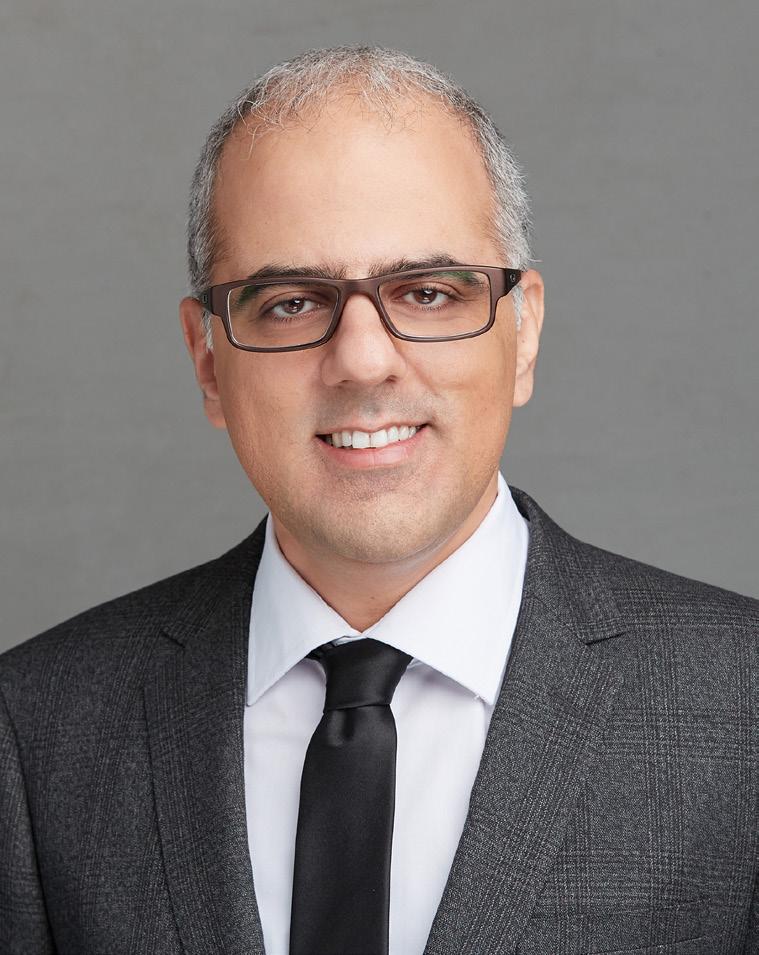
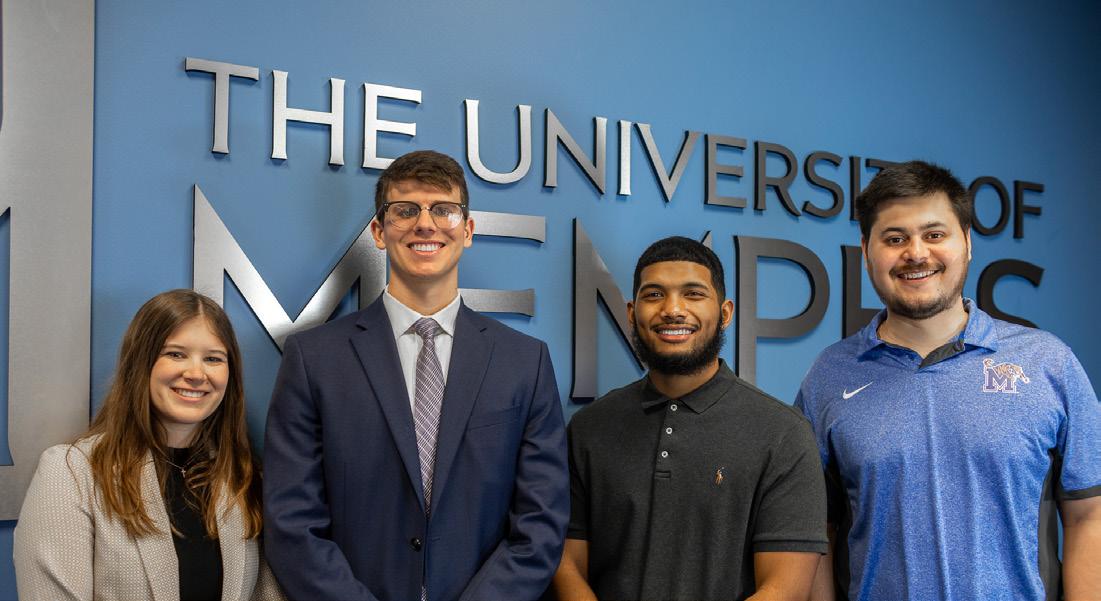
The goal of our project is to design and prototype an intramedullary femoral nail that allows for precise lengthening to facilitate distraction osteogenesis. Distraction osteogenesis, the process of generating new bone between two bone segments, is often used to treat deformities and limb shortenings. Previous treatments typically involve using external fixation devices, which allow for many errors and risks. Some of these risks include limited adjustability and adaptability of the nail. These external fixation devices are also very inconvenient for the patient, minimizing patient comfort. Our design aims to minimize risk, discomfort, and overcomplications for the patient by implementing an internal device. The final design utilizes a compact, high-torque motor, offering reliability and control. This motor, positioned within the nail, engages a threaded drive screw that extends the lower section of the nail.
Team Members
Shaquan S Mayes
Camille Eleanor Holley
Joseph Scott Gartenbein
Faculty Mentor
Dr. Ranga Gopalakrishnan
Client
Department of Mechanical Engineering, UofM
The Ultrasonic Dry Powder Nebulizer (UDPN) project aims to transform pulmonary drug delivery for patients with respiratory conditions. In contrast to your traditional inhaler and nebulizers, treatment may be limited, unsuitable, and inaccessible for longterm drug delivery for patients with more limitations. Dry powder inhalers require forceful breathing, Nebulizers are liquid based and come with a unique set of challenges such as mold, and Metered-dose inhalers or pMDIs require patient motor coordination.
The goal of this project is to design a compact, self-contained, and user friendly Ultrasonic Dry Powder Nebulizer that does not propose the same limitations as existing products on the market. In addition, the aim will also be to provide an accessible long term solution for pulmonary patients.
The social impact of the UDPN project is significant. By increasing accessibility and usability, the UDPN empowers patients with respiratory conditions to manage their health more effectively to
Team Members
Madison Hope Garlock
Travis Raymond Jones
Timothy Dewayne Finnie
Pedro Manuel Rodrigo
Faculty Mentor
Dr. Gladius Lewis
Client Smith & Nephew
The Tigears
The motor functions by a microcontroller which allows for precise lengthening. By doing so, this assembly also provides the user with effortless adjustability, minimizing patient discomfort and associated risks. The entire system is powered by a 12-volt battery, selected for its compatibility and efficiency with the selected motor.
When implanted, the device would be fixated using screws at the various ends of the nail, and after the procedure, the patient could begin the lengthening process using calculated measurements. While the motor used in this nail design would not be able to reverse the lengthening as desired by the team, with the given budget this motor was the most efficient and therefore chosen. Our mentor for this project was Gladius Lewis and the client was Smith and Nephew.
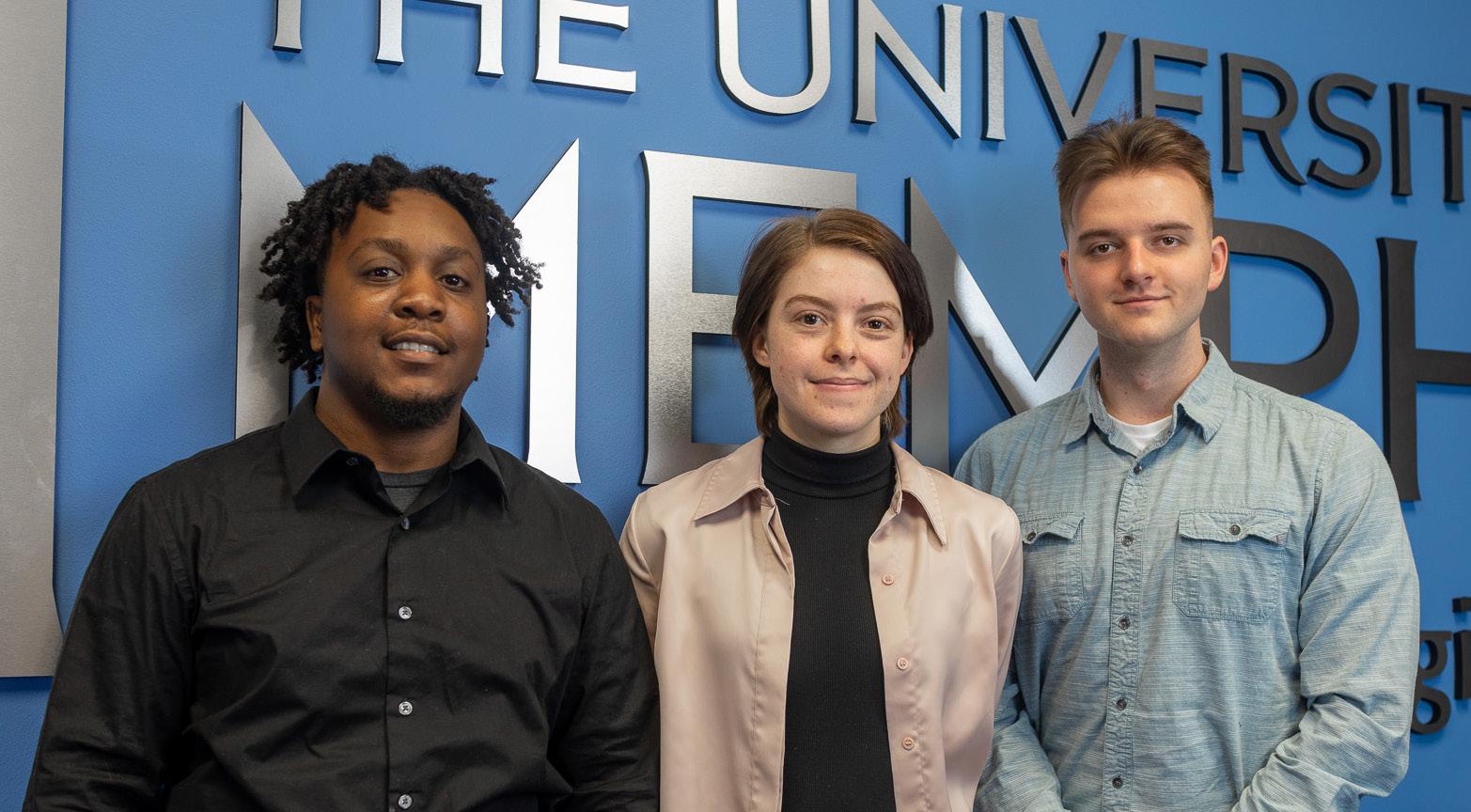
promote independence and improve quality of life. Additionally, the UDPN can contribute to healthcare equity by ensuring individuals with varying respiratory capacities and limitations can access and benefit from advanced drug delivery technology. Inevitably, this will allow promoting inclusivity and reducing disparity in healthcare outcomes among different patient populations.
Based on a patented ultrasonic aerosolization method developed by Dr. Gopalakrishnan’s research team, a UDPN will be developed utilizing ultrasonic standing waves to aerosolize a dry powder. After aerosolization, the product will transfer to a dilution chamber and ultimately be delivered to the patient at appropriate concentration and flow rate. Key objectives to reach throughout this project include increasing accessibility and usability, ensuring suitability for long-term drug delivery, compact and self-contained design, and most importantly designing a device that will be operable at any orientation.
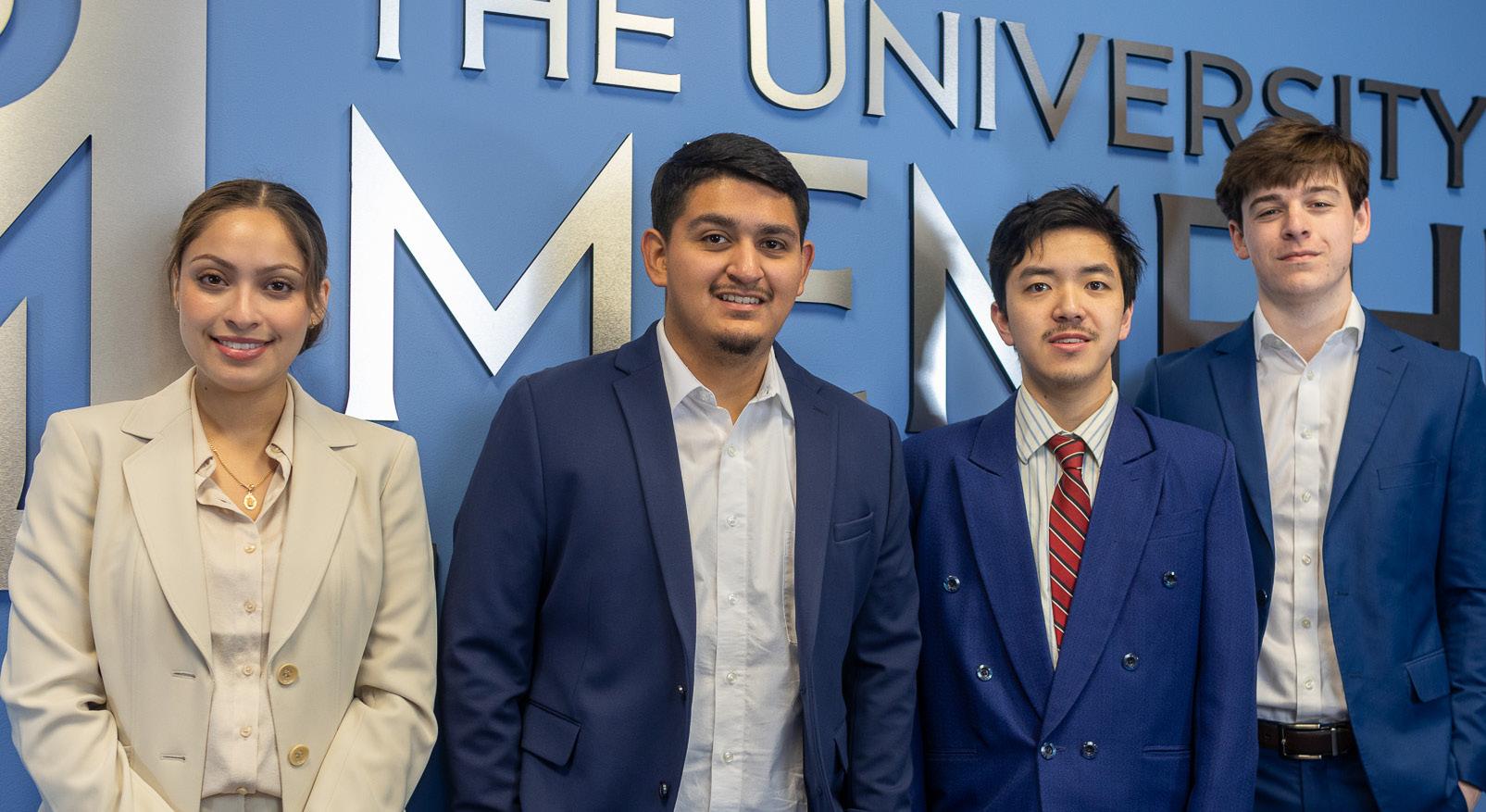
The objective of the ASM (Ankle Stiffness Monitor) project is to create a device that can measure the rotational stiffness of the ankle. This project is for research; the device will be used to measure the rotational stiffness of the ankle of many different subjects to be able to determine the value that constitutes a healthy ankle.
The device consists of two main components, a base and a platform, both made from ABS plastic. The base serves as the frame of the device and looks like a hollow box. The platform rotates on an axis, to prevent movement in the frontal/coronal plane. The axis consists of a steel rod which goes through the platform and base. The rod is connected to the base using steel ball bearings, allowing rotation. The platform is kept in place using nylon bushings between the
Team Members
Victoria Consuelo Rivera
Angel Reyes
John H Vo
William H Barnett
Faculty Mentor
Dr. Yue Guan
Client Department of Mechanical Engineering, UofM
ASM
platform and rod. There is a clearance of roughly 0.25 inches between the base and platform to allow rotation.
The other two important components of this device are the force gage and distance laser, both of which will be used for the automation of the device, which will give outputs of rotational stiffness values. The distance laser will be mounted above the base and platform and will measure displacement from above. The force gage will be mounted under the platform; when the subject inverts the ankle, the force gage will measure in compression, but when the subject everts the ankle, the force gage will measure in tension. A piece of foam will be placed under the platform to prevent the force gage from losing contact with the platform, and also to lightly dampen the device.
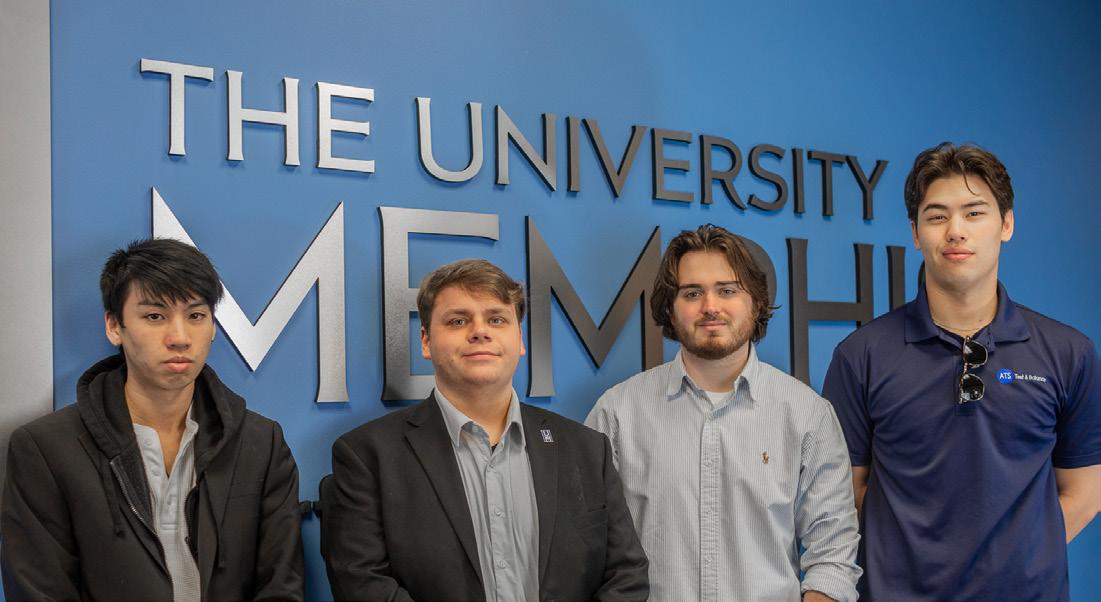
The team is focused on redesigning the connecAon mechanism for a trial femur replacement to replace the current set screws with innovaAve design that reduces the effort required by surgeons during assembly and disassembly. Surgeons uAlize trial femurs following femur resecAon for condiAons like osteosarcoma. They insert implants into the exisAng bone using a femoral stem and then introduce trial segments of various lengths to assess moAon range before implanAng a permanent Atanium device. The team considered factors such as cleanability, reusability, and sterilizaAon techniques, aiming to create a prototype suitable for medical device companies.
The team uAlized an iteraAve approach to designing the ideal connectors. Each member designed their own iniAal prototype and presented their respecAve designs to the
Team Members
Cher Yin Adrian Cheng
Tamren Carl Lenn
Logan R Mcclanahan
Jeffrey L Hamsley
Team Members
Lauryn D’Ann Graham
Navneet Singh Sidhu
Logan Scott Canaday
Joseph Morgan Ward
Faculty Mentor
Dr. Reza Molaei
Client Society of Automotive Engineers (SAE Tiger Baja) Student Organization Mechanical Engineering Department
The Suspenders
Starting in 1976, the Society of Automotive Engineering began to host an annual competition in which universities would assemble teams of engineering students that would design and build their own off-roading Baja vehicles and then race them in various events against other universities’ teams from across the globe. With three competition events annually, each team is given a set of rules and regulations to follow each year to keep the designs new and improving as well as increase the challenge to the students. Students would then get to embody the very spirit of engineering by designing, fabricating, testing, and implementing their designs including but not limited to the frame and roll cage, suspension systems, and drivetrain.
The University of Memphis has competed in the SAE Baja competitions for over a decade until COVID-19 shut down the
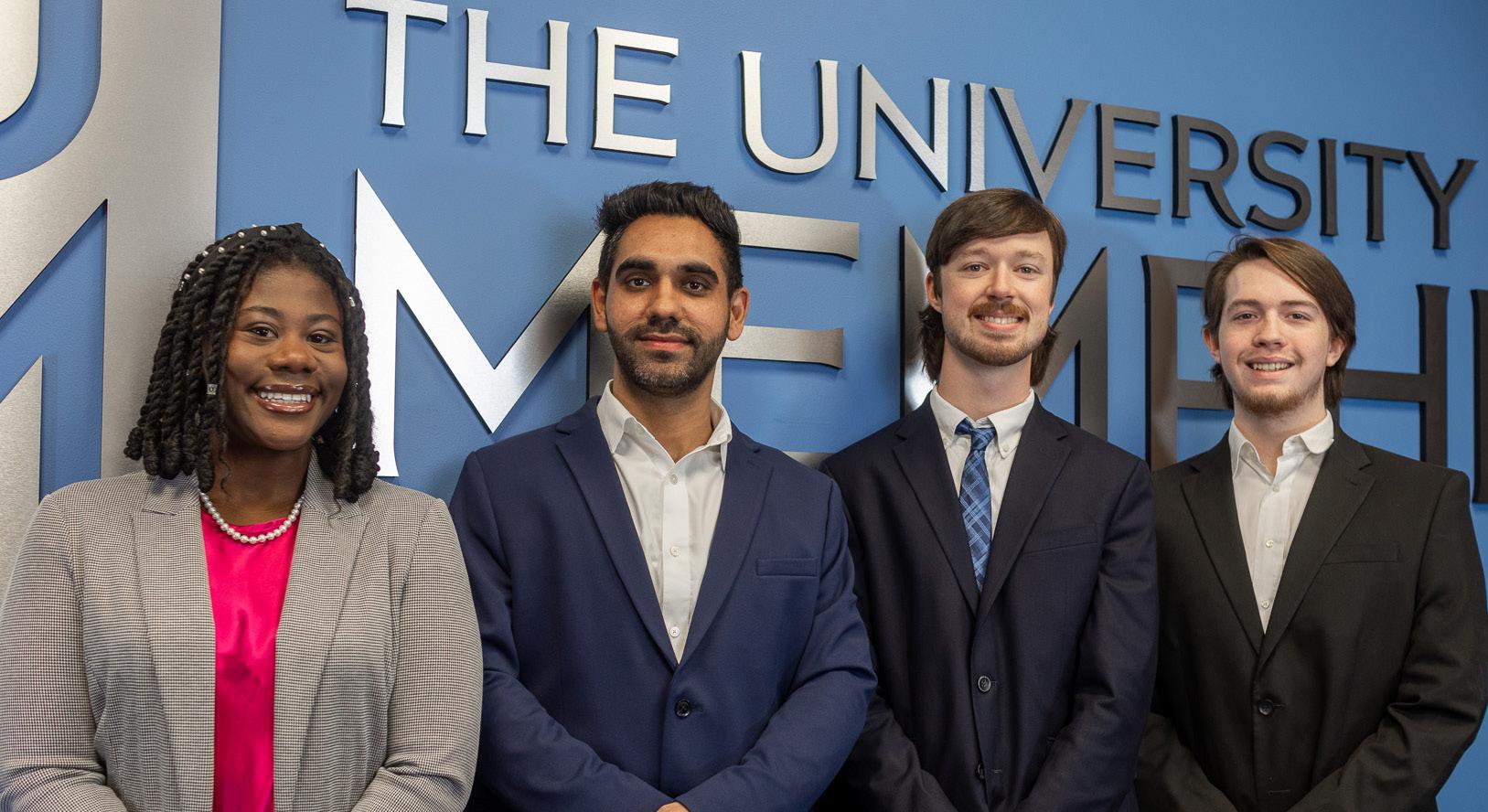
operations of the University of Memphis SAE chapter. This means that the last competition year that the Tiger Baja competed in was in 2019. Ever since then, the club dedicated to it has all but gone away. However, back in 2023, the Tiger Baja club started to be resurrected with new club officers, frame and suspension senior design projects, safety training, and over 50 new interested students attending club meetings to get involved.
The senior design team named “The Suspenders” are the ones in charge of designing and building the suspension systems for the Tiger Baja vehicle that will outshine all others while still following the SAE rules and guidelines. This project, along with the Frame design team, will revitalize the Tiger Baja SAE organization and bring it back to its previous standing as a prominent organization within the University of Memphis.
Team Members
Koby Garret Drake Kurris Allen Crowder
Aaron Lee Stanfield
Joshua Alan Polk
Faculty Mentor
Dr. Marchetti
Dr. Foti
M-Town Flyers
Our team’s project is to design, build, and fly a handmade remote-control airplane that will compete against other teams from all over the world in the AIAA’s Design/Build/ Fly competition. This year’s competition involved us having to create an airplane that will have to carry peg dolls to simulate pilots, passengers, EMTs, and a patient as well as a weight disguised as a medical cabinet that will need to be placed inside the airplane through a door on the side of the fuselage. This is to simulate a short take off and landing, or STOL, medical transport vehicle.
The airplane must be able to take off within 20 feet, complete 3 laps around a designated flight path, and land within 5 minutes. The competition rules also give constraints for different parts of the design like maximum wing width and
Faculty Mentor
Dr. Daniel Foti
Client Smith & Nephew
Hip and Knee Designers (HAKD)
engineers at Smith and Nephew. From their criAques the team converged on a design that combined some elements of two of the iniAal prototypes and developed them into a coherent improved connecAon.
The improved connecAon eliminates the need for threads and streamlines the connecAon process. An L-shaped port on the female end, combined with a precisely engineered tab that snugly fits within the port on the male end, represents the core of this new design. Designed to eliminate excessive manipulaAon by the surgical team, the locking tab is spring-loaded and firmly seats upon sufficient rotaAon. The team succeeds in simplifying procedures for surgeons while simultaneously enhancing the overall efficiency of femur replacement surgeries.

battery size. The airplane must also be designed to have a parking configuration that will have to fit within a 30-inch parking spot. With all this in mind, we designed an airplane with a 60-inch wing and a 1140-inch wing area to have a high surface area that will increase lift to make the 20 feet take off. We designed the fuselage to be able to split and fold over right behind the wing so that the tail will be resting on top of the wing and fitting within the 30-inch parking spot.
The entire airplane was made from balsa and plywood that was cut out into parts by a CNC machine and glued together by hand. The airplane weighs 7 lbs. and will be able to hold 3 lbs. of extra weight in flight as well as 10 passengers.
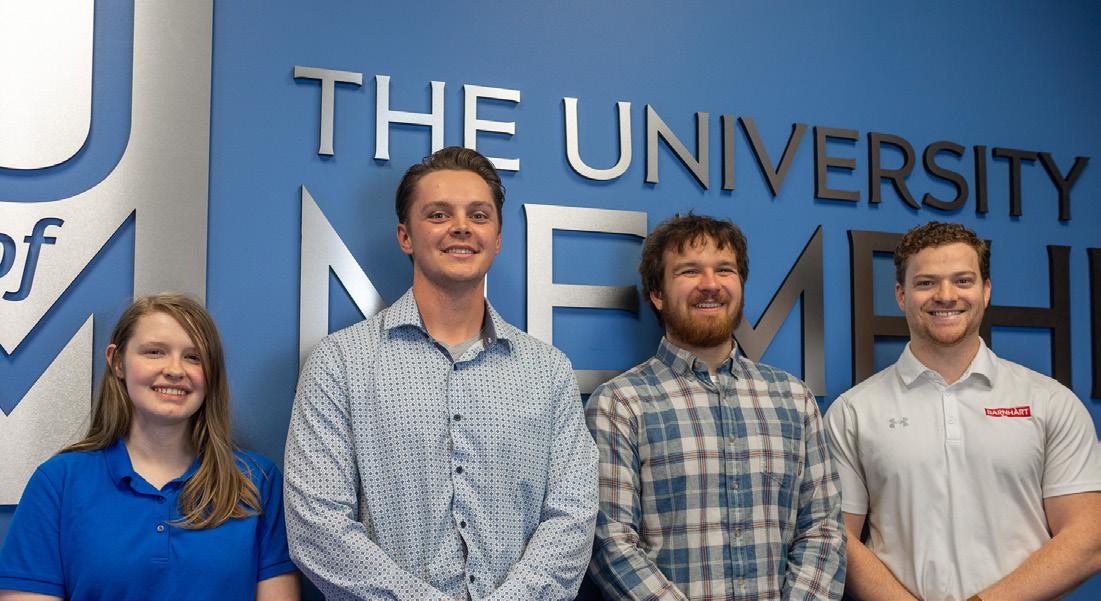
Baja SAE competitions challenge student teams to design and build a single-seat, all-terrain, sporting vehicle whose driver is contained within the structure of the vehicle. The vehicle is to be a prototype for a reliable, maintainable, ergonomic, and economic production vehicle which serves a recreational user market. The vehicle must be capable of safe operation over rough terrain including obstructions such as rocks, sand, logs, steep inclines, mud, and shallow water in any or all combinations and in any type of weather. One of the most crucial components to conquer these conditions is the frame. Dr. Molaei and the University of Memphis Tiger Baja Club have tasked our team with designing this frame for the 2025 competition. The frame consists of a roll cage that will protect the driver and a roll envelope that will protect the engine and fuel tank. As a
Team Members
Andrea Elizabeth Salazar
Joshua Hassan Dabbous
Lauren Valdes
Faculty Mentor
Dr. Yuan Gao
Client Department of Mechanical Engineering, UofM
Coagulation Innovations
The project sought to pioneer a transformative approach to blood coagulation monitoring by introducing a cutting-edge Point-of-Care (POC) portable device. Utilizing the Xurographic manufacturing method and incorporating a double-sided adhesive polyester film, this innovation offers a sophisticated solution for rapidly measuring clotting blood viscosity and analyzing coagulation levels at the point of care.
Blood coagulation plays a critical role in maintaining cardiovascular health, and irregularities in this process can significantly increase the risk of heart disease and related complications. Traditional methods for assessing coagulation levels involve large sample requirements and time-consuming laboratory tests, which delay critical interventions and exacerbate patient outcomes. By contrast, the proposed device promises nearly immediate results, enabling healthcare providers to make timely and informed decisions regarding patient care. Using Xurographic manufacturing, the device will be engineered
Team Members
Kelsie Rae Dorman
Kevin J Gach
David Thomas Braese
Kyle Allen Sumner
Faculty Mentor
Dr. Reza Molaei
Client Society of Automotive Engineers (SAE Tiger Baja)
Student Organization
Mechanical Engineering
Get Framed
prototype of a commercial product, the design must accommodate drivers of all sizes from the 95th percentile male to the 5th percentile female. All drivers must meet the roll cage minimum clearances provided by Baja SAE, and fit into a comfortable driving position, while wearing all the required driver’s equipment.
The cage must be designed and fabricated to prevent any failure of the cage’s integrity during normal operation or during a collision or roll over. The roll envelope must leave enough clearance for a Kohler CH440 engine, the fuel tank, and connections to the drive train, which will be designed in a later semester. FEA was utilized to verify that our frontbraced 1020 DOM frame will be able to give next year’s Tiger Baja team a competitive chance at winning while simultaneously keeping the driver safe.
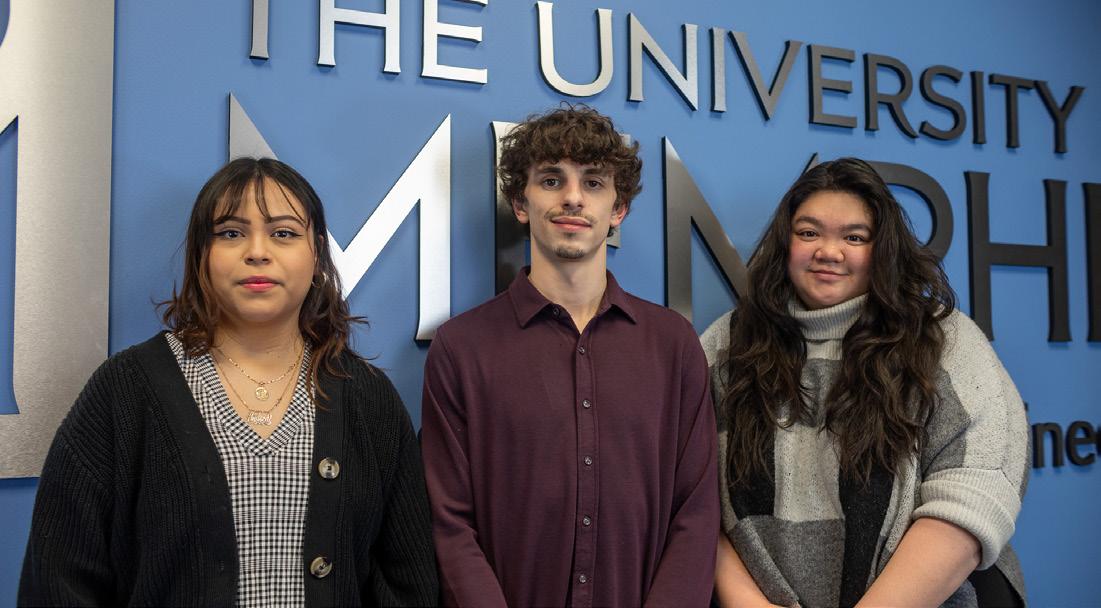
with precision and efficiency, ensuring cost-effectiveness and reliability. Using a double-sided adhesive polyester film as the primary material offers several advantages, including flexibility, durability, and biocompatibility, making it ideal for medical devices.
The impact of this project extends beyond the realm of medical technology; it has the potential to revolutionize healthcare delivery by empowering clinicians with real-time data to guide patient management strategies. The device could significantly improve patient outcomes and reduce the burden on healthcare systems by facilitating early detection and monitoring of blood coagulation abnormalities. Furthermore, the implications of this innovation are particularly significant for individuals at risk of heart disease, where timely intervention based on accurate coagulation assessments could be lifesaving. By enabling proactive and personalized care, the project aims to address a critical gap in current healthcare practices and enhance the overall quality of patient care.
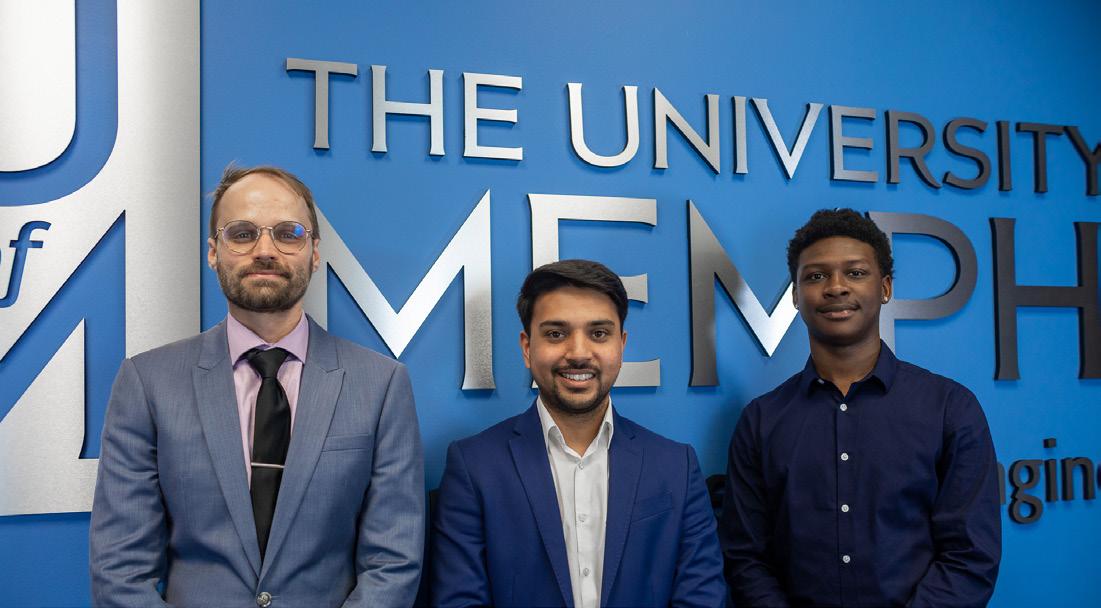
The Collegiate Wind Competition (CWC) is an event sponsored by the U.S. Department of Energy (DOE). One of the core tasks assigned to participating teams is the design and engineering of a base and monopile structure for wind turbines. The objective is to develop a robust foundation capable of supporting a small-scale wind turbine in diverse environmental conditions.
For this competition, our team focused on crafting a specialized base tailored for insertion into a sand-water foundation. Our base design concept revolves around an innovative approach: an auger-style base featuring a flat plate on top, encircled by a hollow cylinder. This design aims to enhance stability and optimize performance in a sand-water environment by maximizing surface area and utilizing the friction forces from contact with the sand. The auger mechanism facilitates ease of installation by effectively drilling into the sand and water substrate, ensuring secure anchoring. The incorporation of a flat plate at the top of the auger provides additional support and stability, distributing the load evenly across the top of the sand’s surface.
In the electrical controls system, each component plays a crucial
Team Members
Damon Victor Dowd
Spencer Ellis McKnight
Geoffrey A Warberg
Faculty Mentor
Dr. Jeffrey Marchetta
Client ASHRAE
Under Pressure
A variable frequency drive (VFD) is a device that can be installed onto pumps or other motors in order to change them from single speed to variable. Flow rates often need to be changed in HVAC systems where different amounts of chilled or hot water are needed to match the cooling or heating loads of a particular space.
Traditionally, varying flow rate is done through the use of throttling valves or installing a new pump/impeller. The issue with these traditional methods is that the flow rate is reduced while the pump is still consuming the full amount of power, effectively reducing the efficiency of the pump.
VFDs are able to adjust the flow rate by changing the speed of the pump directly which adjusts the flow rate while also reducing the power consumption of the pump overall. This leads to overall
Team Members
Adrian David McCann Lewis
Brian William McDowell
Nihar Vinodbhau Patel
Marlon Aleeke Young
Faculty Mentor
Dr. Yong Hoon Lee
Client
U.S. DOE Collegiate Wind Competition 2024
Fans of Metal
role in ensuring the efficient and safe operation of the wind turbine. Wind energy captured by the blades of the wind turbine is converted into mechanical energy in the motor. This motor was selected based on torque requirements, efficiency, and compatibility with the power source. Linear actuators are integrated to control the pitch of the turbine blades. By dynamically altering blade pitch, the system can respond to changes in wind speed and direction, enhancing overall performance. Passive yaw control was implemented to orient the turbine into the wind direction. Passive yaw control relies on aerodynamic forces and turbine design to naturally align with the prevailing wind direction.
Throughout the design and engineering process, our team employed computational modeling and simulation techniques to validate the structural integrity, durability, and performance of our base and monopile design. Iterative refinement and optimization were key components of our approach, ensuring that our solution meets rigorous technical standards while remaining cost-effective and practical for real-world deployment.
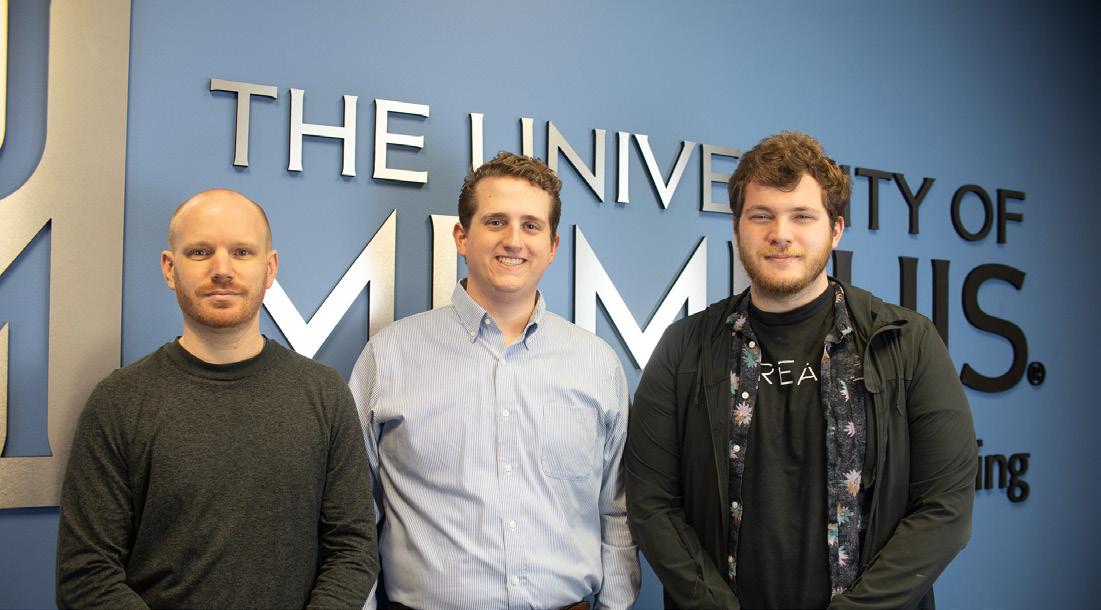
reduced energy costs as well as operational and maintenance savings due to the pump not having to constantly run at full speed. The design itself consists of a piping loop filled with water, a reservoir, and the pump equipped with a variable frequency drive. The demonstration will show the difference in power consumption between the pump operating with the throttled valve and the pump operating under variable speed. The system also contains different sensors for reading pressure and flow rate. The entire system is placed on casters and designed within the dimensions of a standard door frame, making the design portable for Memphis ASHRAE to take it to local K-12 schools to demonstrate energy saving technology to students.
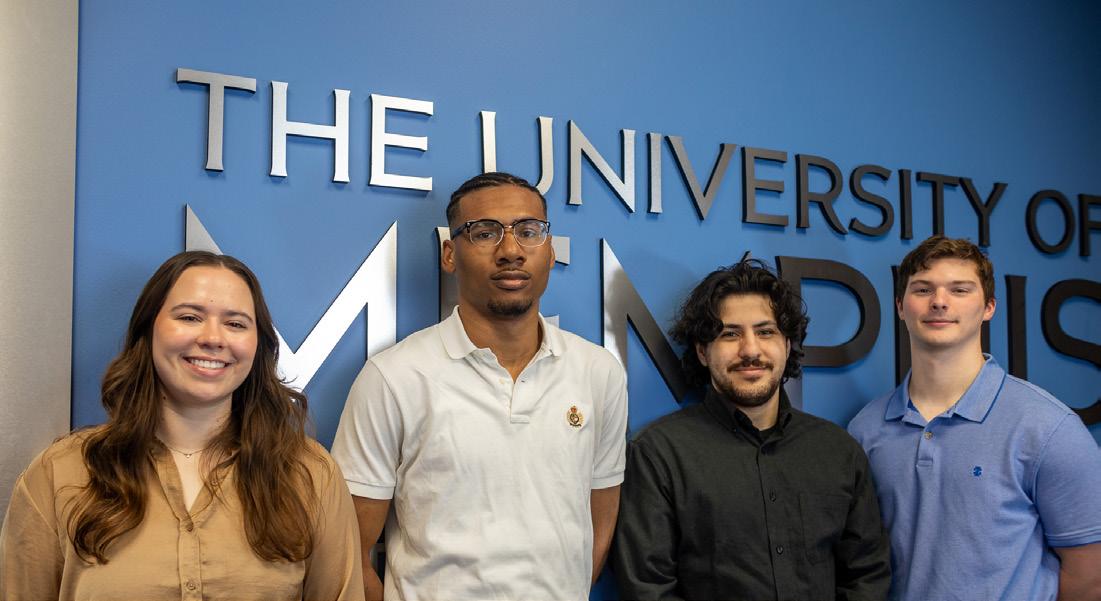
Energy localization can occur in periodic structures such as arrays of oscillators and lattices due to nonlinearities and discreteness, even in systems lacking impurities or defects. This phenomenon manifests across mechanical, chemical, and biological systems, yet its underlying mechanisms are not yet fully understood. This project’s main objective is to create and test a prototype of interconnected nonlinear oscillators to advance research in this field. An individual oscillator is comprised of a steel cantilever with a magnet attached to its tip, the magnet is then positioned near an opposing stationary magnet. This simple setup enables investigation into the manipulation of energy localization through external stimuli.
For this project, our design differs from previous apparatuses through some key design features: The upper magnet array can vary its distance from the oscillators, the magnets of the upper array will be able be switched out to change their polarities, and
Team Members
Blake Allen Acree
Daveren Keaton Coburn
Joseph James Saucier
Aleks Vincent
Faculty Mentor
Dr. Yong Hoon Lee
Client
U.S. DOE Collegiate Wind Competition 2024
Team Betz
With the growing interest in optimization of wind energy technology, the US DoE funds an annual competition to explore micro-wind turbine design. As part of their Senior Design experience, two groups were tasked with collaborating to design and build a functional prototype wind turbine, with each group independently responsible for their own portions of the project. Constraints for the geometry and functional parameters of the wind turbine come from the 2023-24 Collegiate Wind Competition (CWC) rulebook while all other aspects of the project design are at the team’s discretion.
With the broad variance in wind turbine design; performance, efficiency, and feasibility all had to be considered. As this is the first year that the University of Memphis has
Team Members
Jennifer Elizabeth Farler
Gabriel Williams
Yusef Marwan Qazzaz
Stewart Waterman Kerby
Faculty Mentor
Dr. Vipin Agarwal
Client Department of Mechanical Engineering, UofM
Coupled Oscillator Array Senior Team (COAST)
there is a total of 10 oscillators.
To achieve this design the steel oscillators will be bolted to an aluminum base plate using small L-brackets, and the springs between the oscillators will be attached using weak sheet magnet glued to the ends of the springs and the faces of the oscillators. The magnets on the ends of the oscillators will be fixed in place using small brass tubes and epoxy. To account for the changing of the upper magnet array’s polarity we have designed a system of 2 interchangeable plates with fixed magnets of opposite poles. These plates can also shift back and forth, allowing us to have one or two magnets coupled with each oscillator. The baseplate and upper array plate will be secured around a coupled screw-jack system which will allow for the easy manipulation of the upper array’s distance from the baseplate. Finally, the whole apparatus will be supported on guide rails and carriages to allow for translational motion along the axis of our input force.
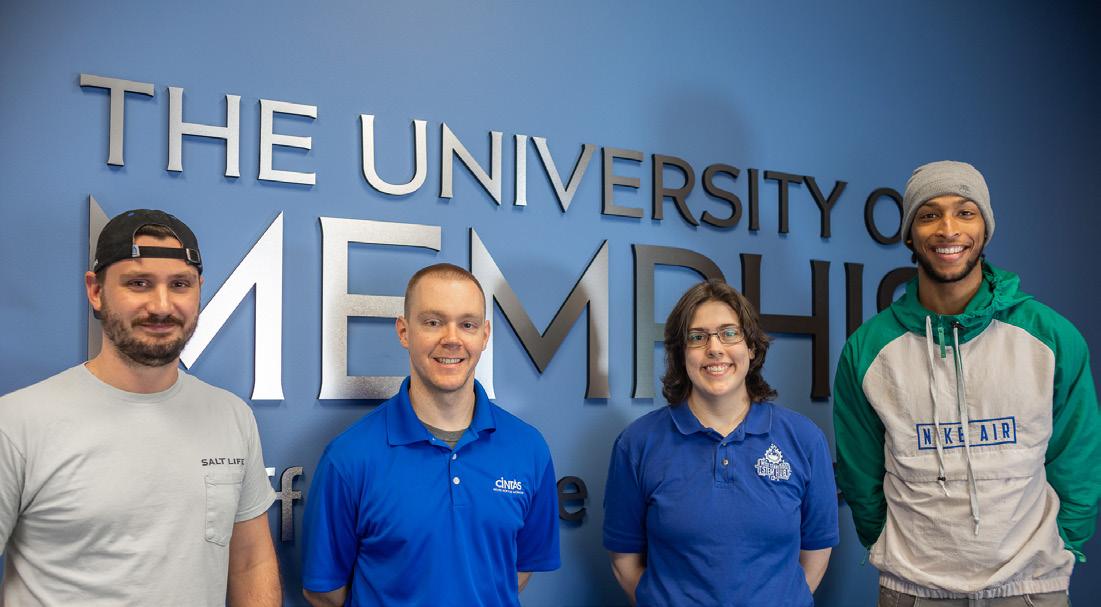
participated in this competition, there were no previous designs or components to incorporate, leaving the team with flexibility in design decisions.
The most critical design elements include the blades, pitching mechanism, and generator. Using the HCOE Design Lab, most components that make up the turbine were fabricated with thermoplastic polymers using Fused Deposition Modeling (FDM) 3D printers. The assembly hardware and electronics are the only outsourced elements. The project resulted in a functional micro-wind turbine that adheres as closely as possible to CWC rules. Although the UofM has not been selected for the final phase of the competition, this design may serve as the first of many iterations that will take future teams to the competition floor year after year.
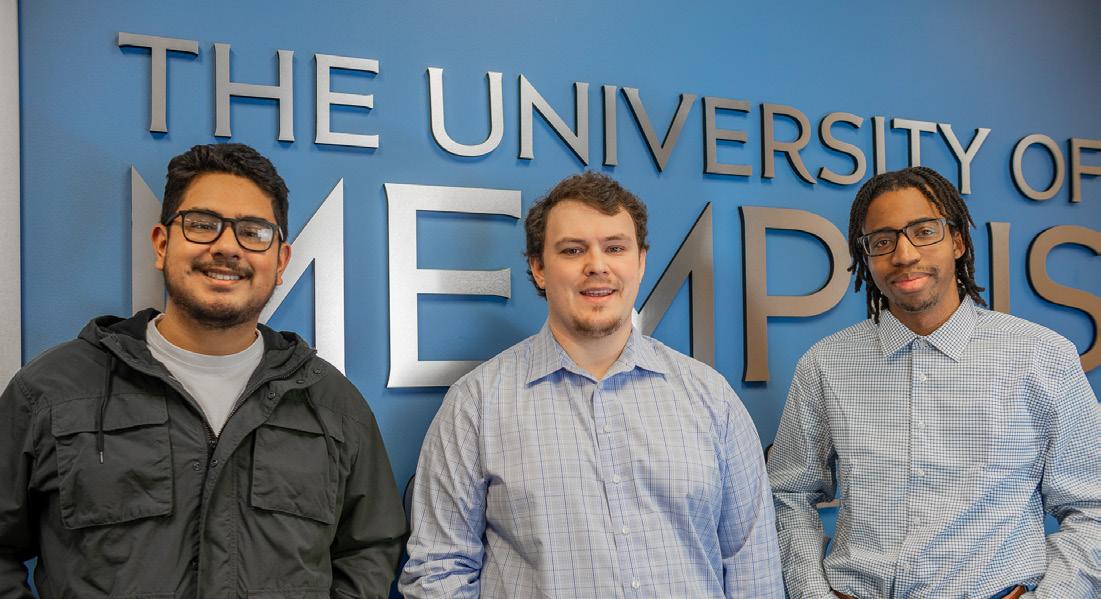
Our swinging door finger guard project aims to address inefficiencies in the manufacturing process of a retractable nylon fabric shield designed to prevent finger injuries from door hinges. The project’s primary goals include identifying the root cause of manufacturing inefficiencies, optimizing the production process to reduce time and labor costs, and enhancing the product’s marketability and profitability. As a byproduct of these positive changes, we hope to see improvement in employee morale.
The project background reveals that while the current finger guard design is effective, the manufacturing process is labor-intensive and time-consuming. The process involves intricate tasks such as drilling holes along the spine of the guard and threading wires, each consuming nearly 30 minutes per unit. As order volumes increase, these inefficiencies become more notable, impacting profitability.
Team Members
Darius Leon Brown
Fernando Enrique Lobos
Landon J Murrellr
Faculty Mentor
Dr. Alex Headley
Client
National Guard Products, Inc
Lock Block
Additionally, the design summary points out a critical flaw in the punch tooling, which requires constant maintenance and replacement, adding to production costs.
To address these challenges, our team proposes possible solutions such as exploring pneumatic drill mechanisms and implementing equipment usage, like a modular workplace fixture. Prototypes of potential solutions will undergo trials to assess their feasibility and effectiveness. The project emphasizes sustainable and reproducible changes to ensure long-term viability and market competitiveness. Ultimately, the swinging door finger guard project aims to deliver a streamlined manufacturing process that improves efficiency, reduces costs, and maintains product quality. By aligning with the NGP, Inc.’s profit goals and market aspirations, the project seeks to position the finger guard as a leader in safety solutions with enhanced efficiency and market appeal.
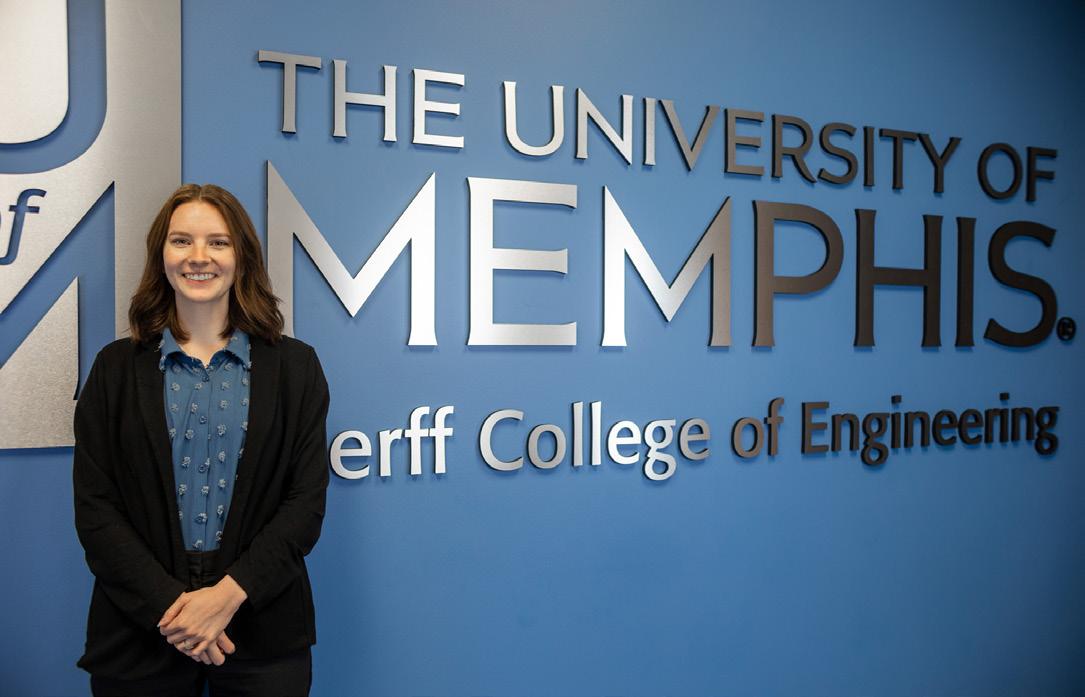


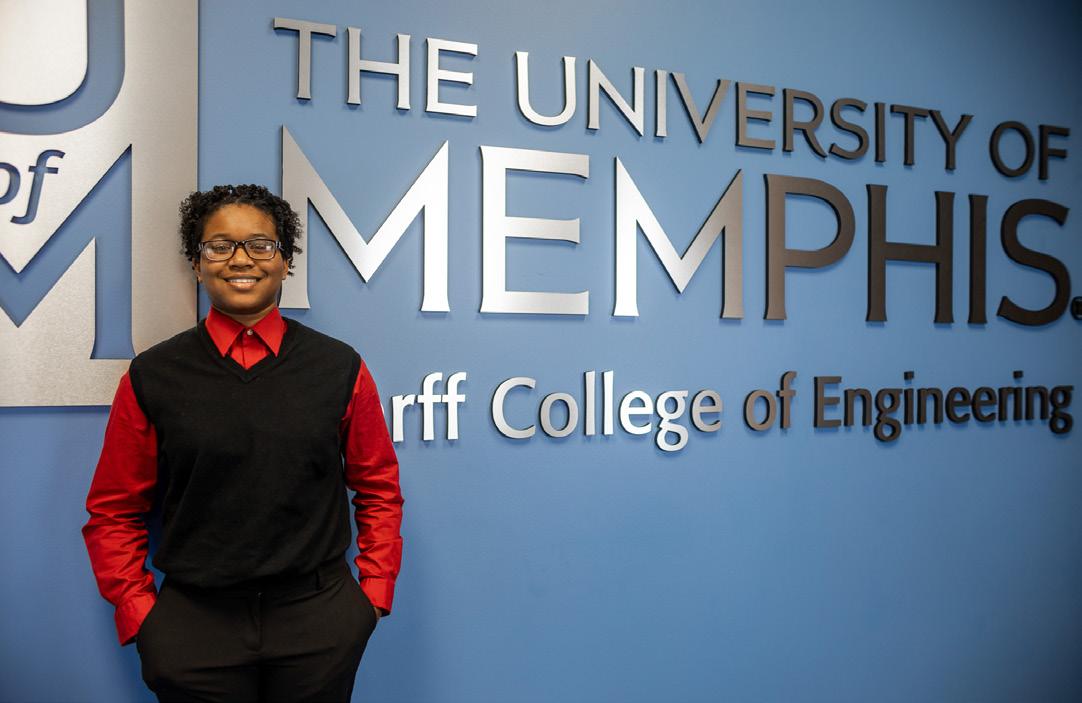




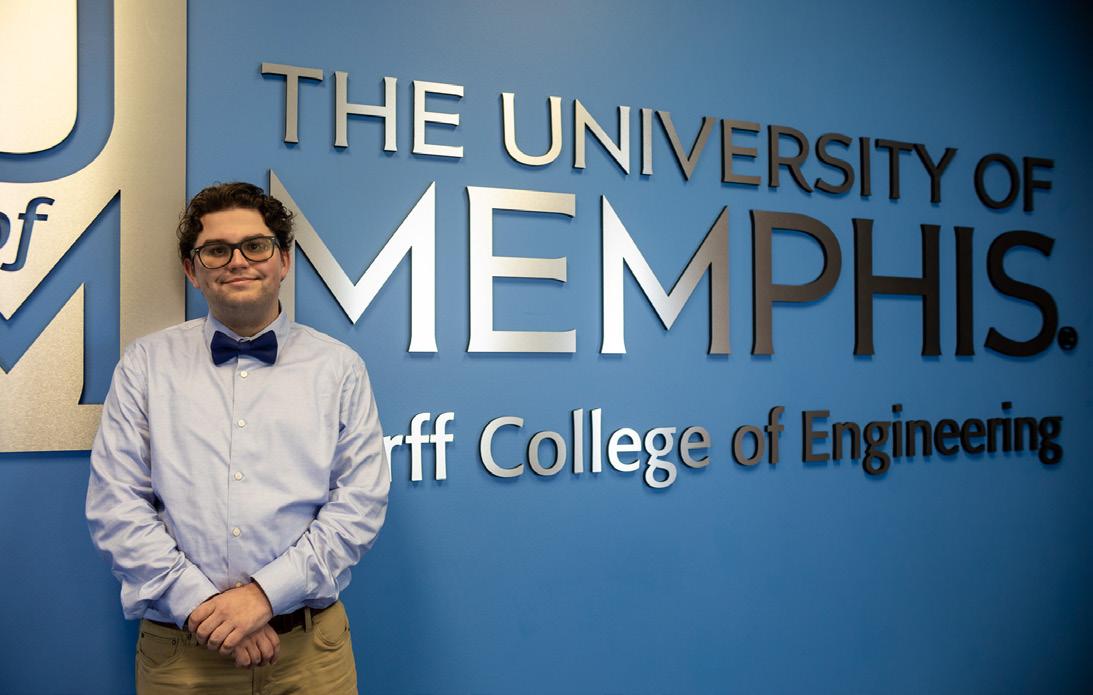
Michael Floyd
Faculty

Hamzah Ghrayeb
Faculty
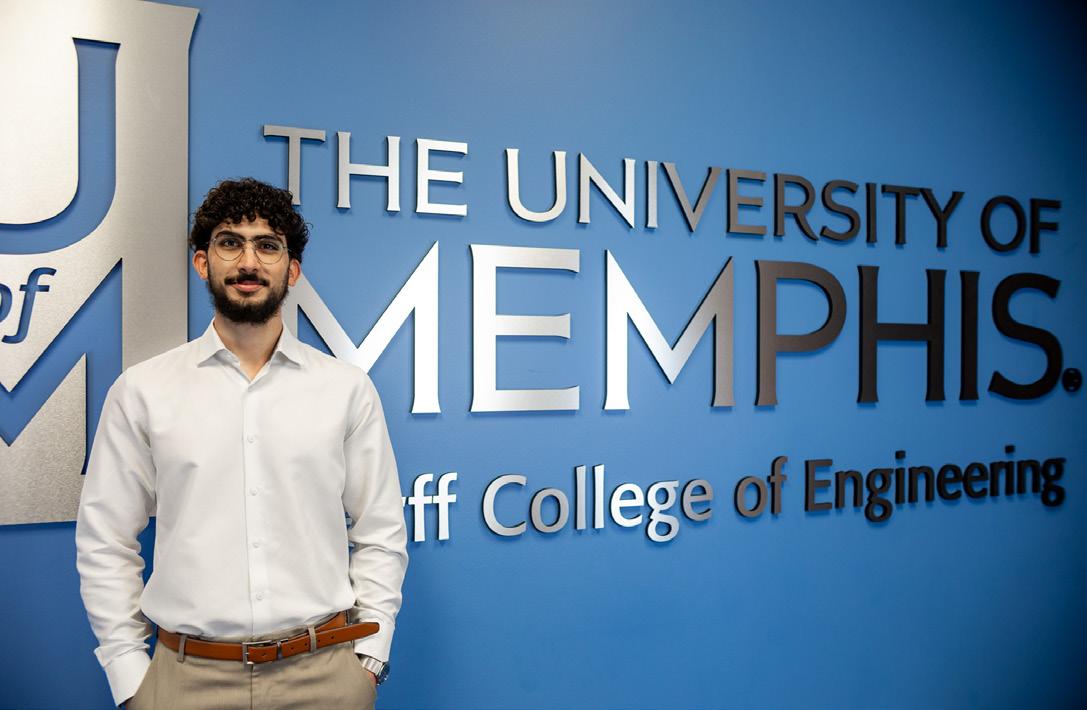

RJ Glover
Faculty Advisor: Dr. Kevin Berisso
Project: Inventory Management System

John Green
Faculty
Project: Recycling
Darius Hamilton
Faculty Advisor: Mr. Faruk Ahmed
Project: Kinect Security
“Kinect Security” is a motion detection and facial recognition system leveraging Microsoft Kinect and OpenCVSharp to detect and record intrusions. The idea of the project came about with the goal to re-use an older piece of technology instead of possibly e-wasting. The project’s success was evaluated through accuracy testing.
Emanuel Jackson
Faculty Advisor: Mr. Robert Hewitt
Project: Attachable Umbrella Strap

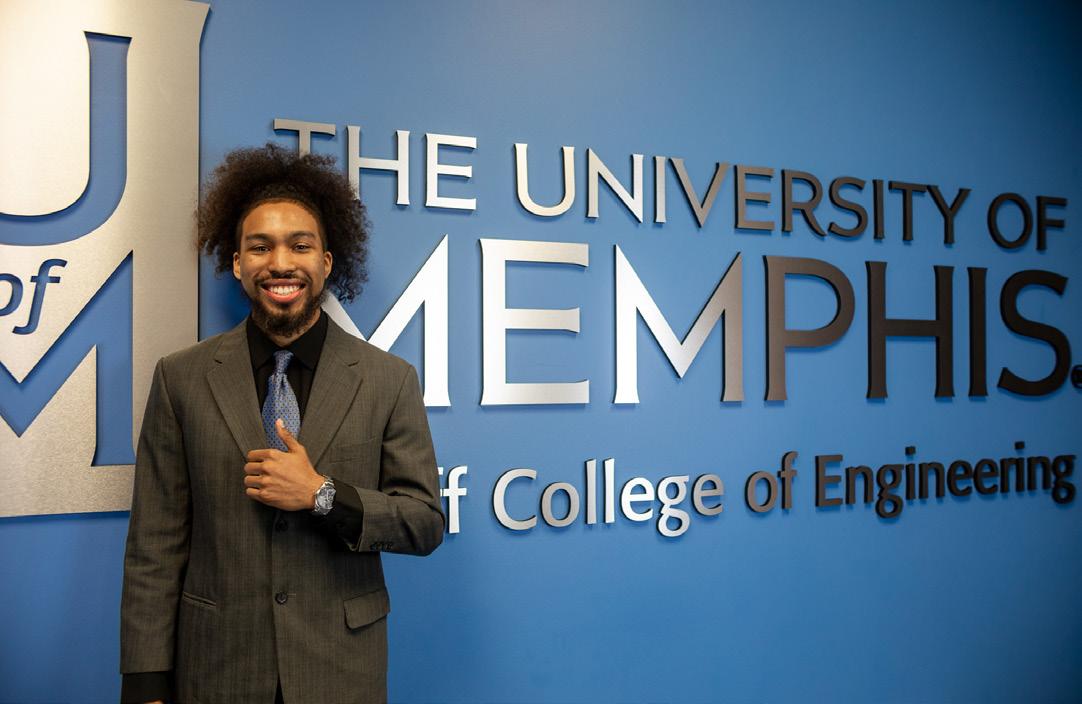
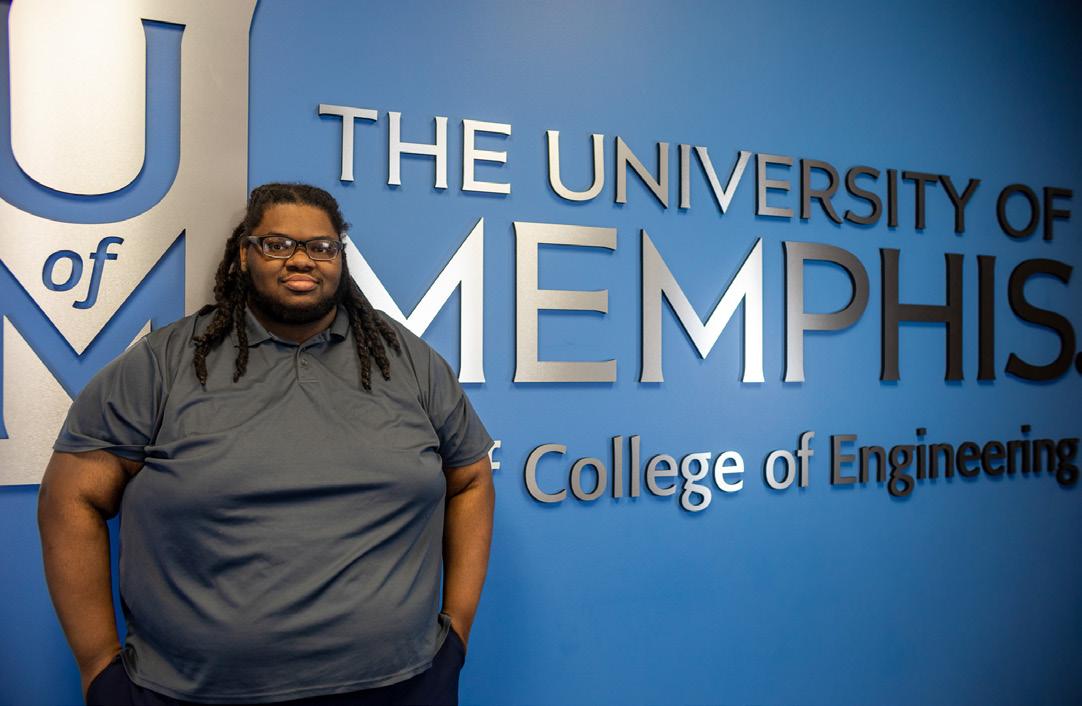
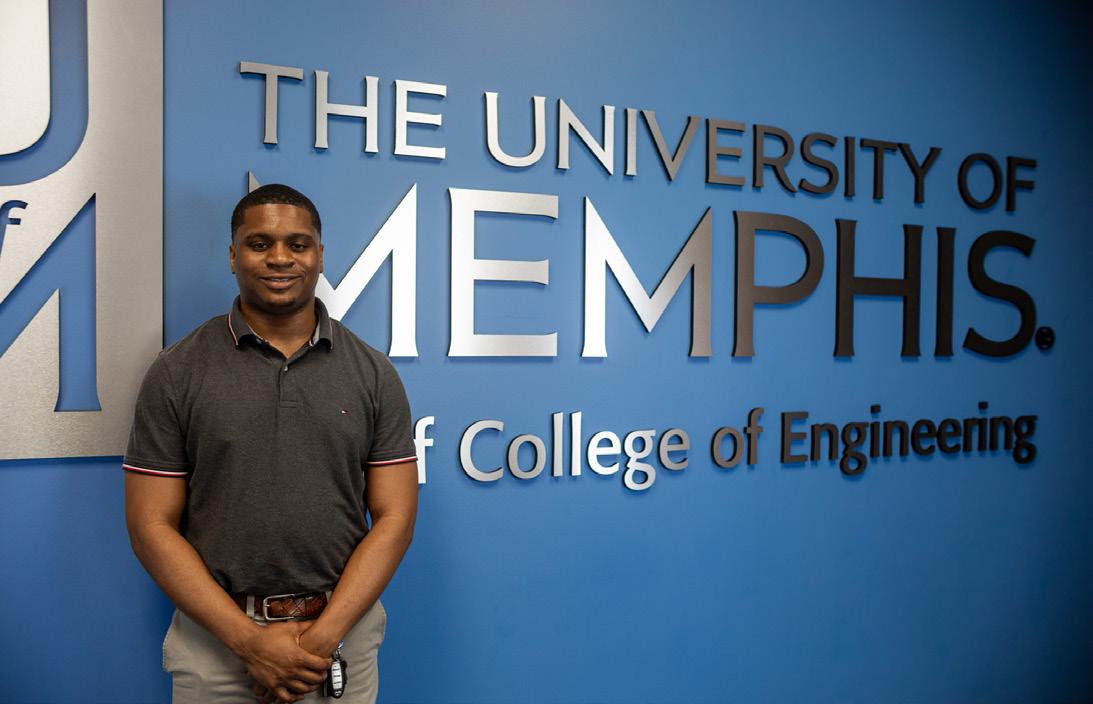
Taurus Gregory
Faculty Advisor: Dr. Faruk Ahmed
Project:
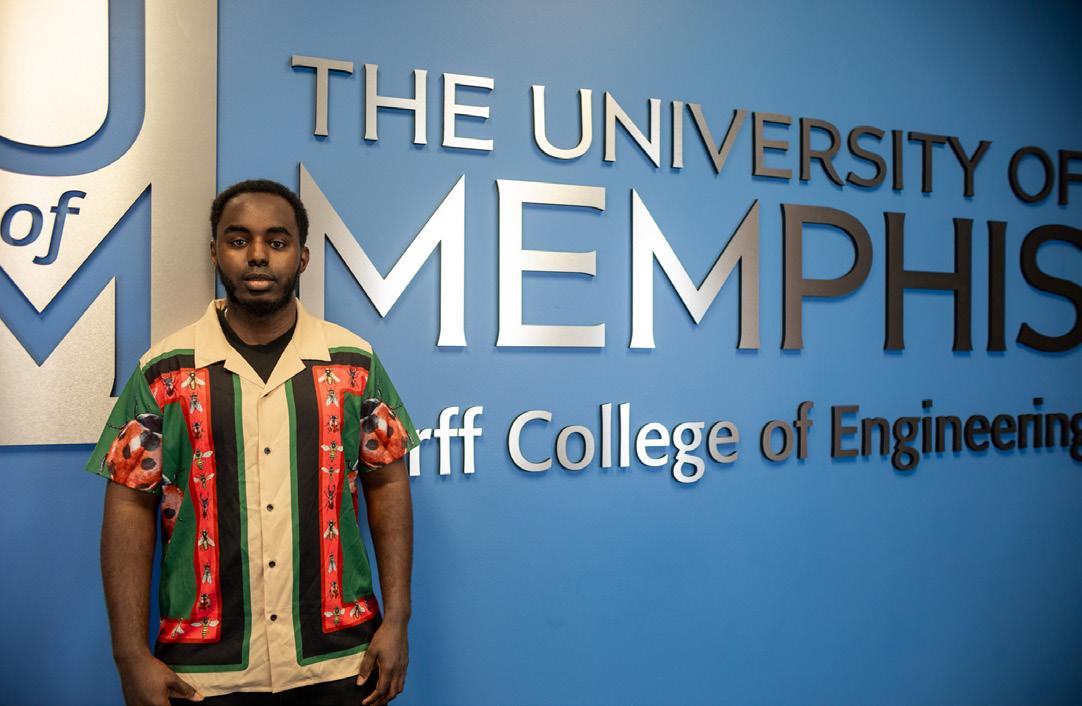
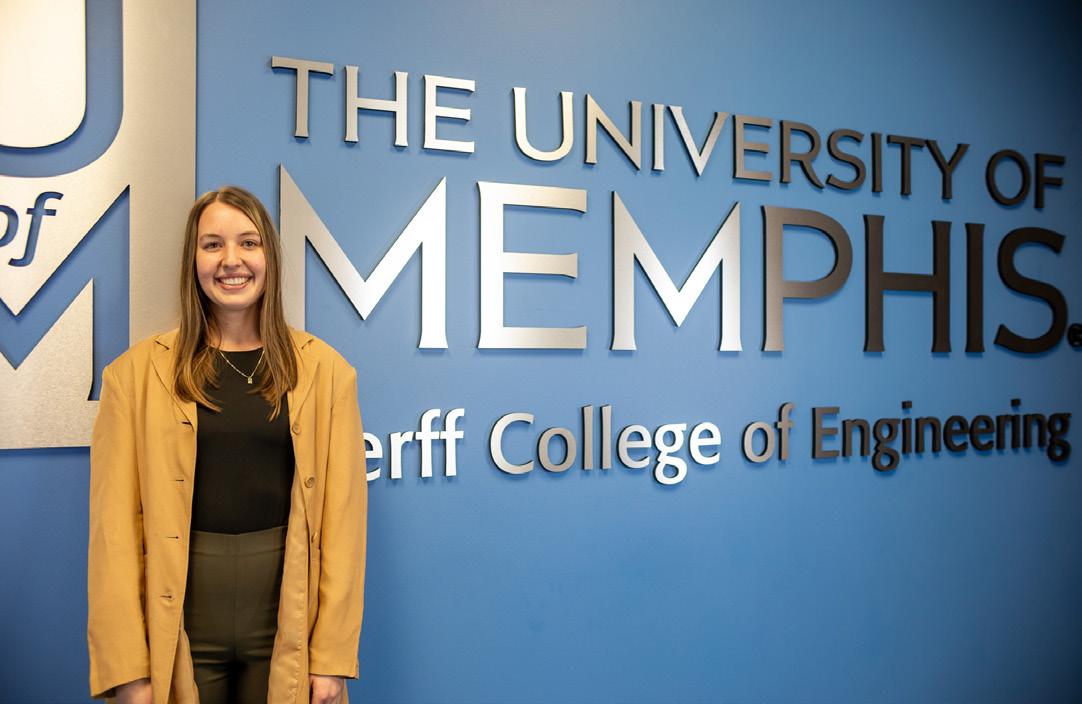
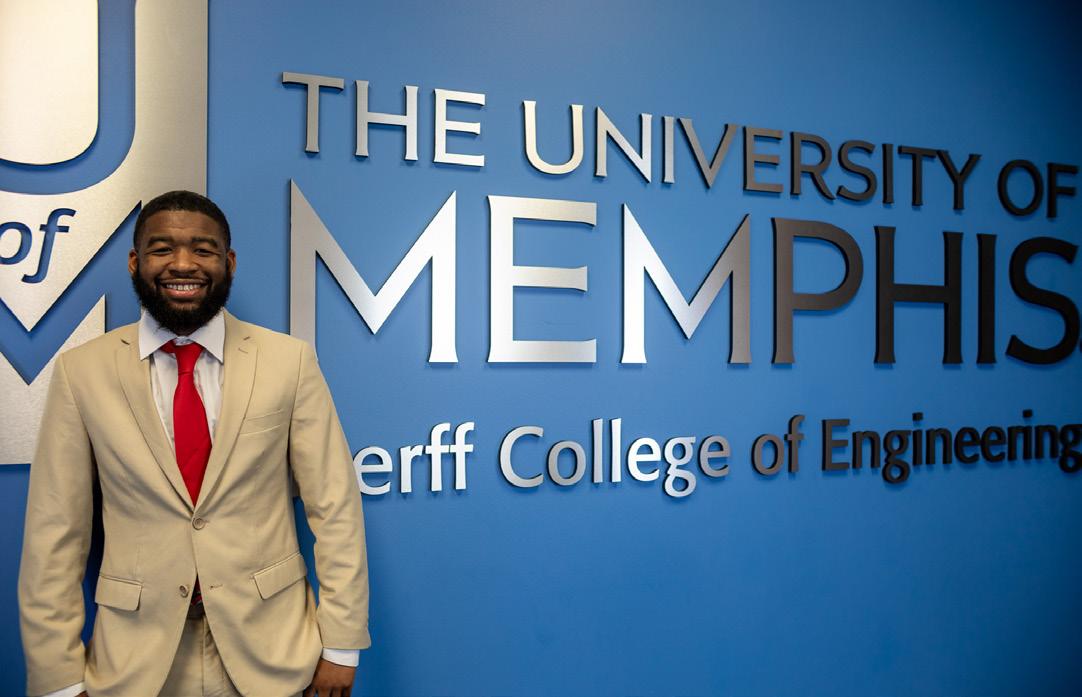
Ladrian McCurrie
Faculty Advisor: Mr. Rajesh Balasubramanian
Project: Continuous Improvement Project For OPACHS improved service installation processes using DMAIC methodology, enhancing customer satisfaction and operational efficiency. Analytics transformed performance metrics, reducing response times and service deductions. Collaborative efforts and leadership insights boosted service quality and operational agility.

Will Norwood
Faculty Advisor: Mr. Matt Hale
Project: Injection Molded Firearm Storage
This project aims to create a safe, surface-mounted firearm storage device that works in conjunction with the internal firearm elements to reduce complexity and cost. Utilizing resources including Siemens NX modeling software and 3D printers, the project will deliver functioning prototypes for Glock handguns (ranked most popular in the world).
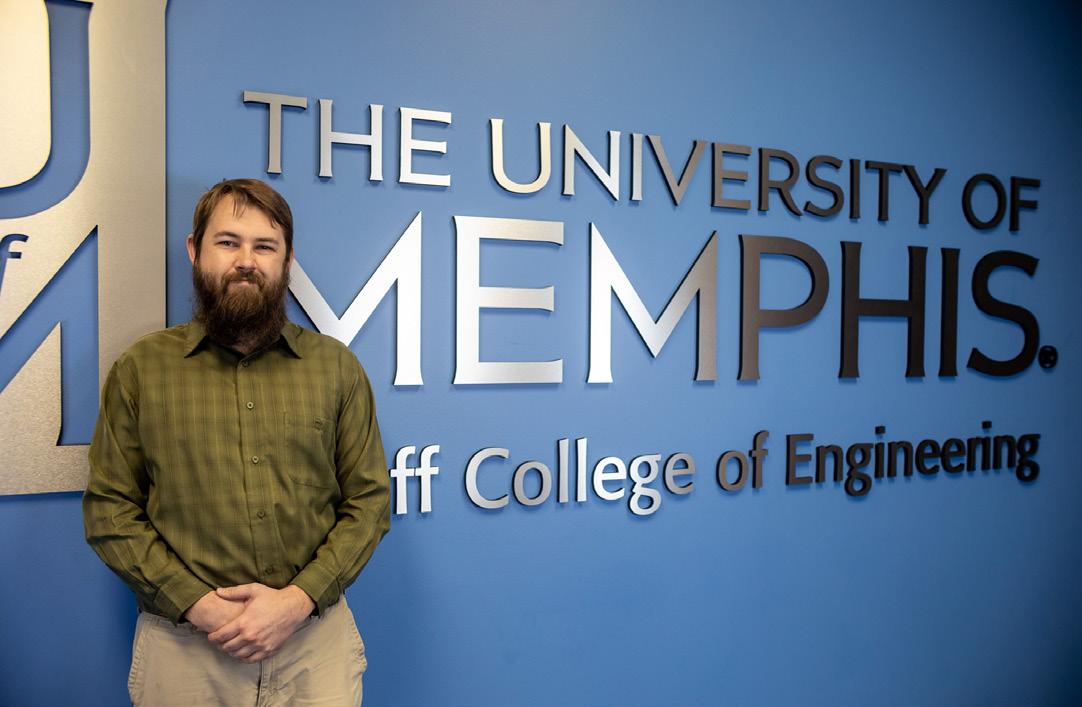

Rameez Mirza
Faculty Advisor: Mr. Rajesh Balasubramanian
Project: Improving First Article Inspection and Testing
A local company here in the Memphis area was having difficulty inspecting and testing their first article samples in a timely manner. This project uses the DMAIC cycle to improve their First Article Inspection (FAI) process and aims to decrease the time required from nineteen to fourteen days.
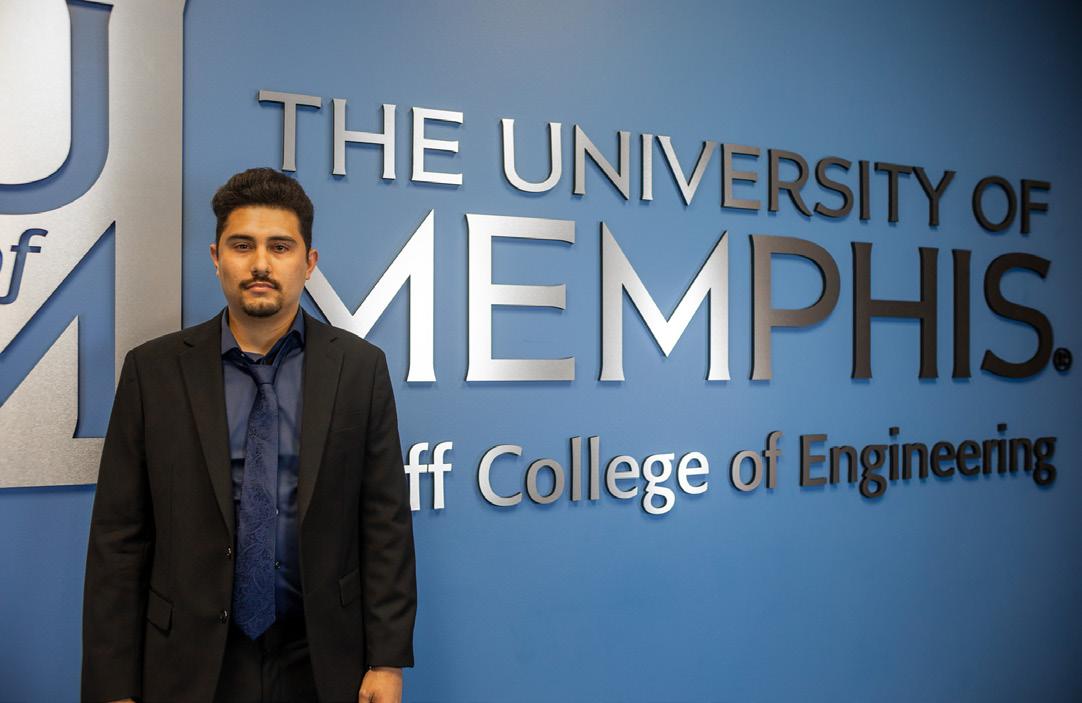
Rolando Sanchez
Faculty Advisor: Mr. Robert Hewitt
Project: Robot Track Injection Molding
I’m working on a Robot Track using injection molding. My objective for this semester was to design the 3D mold prototype on NX and the wheel where the track will be tested. My goal was to improve the robot tracks that can move easily in different terrain.
Jed Porter
Faculty Advisor: Mr. Robert Hewitt
Project: OBS Ford Bumper
This senior project is about designing an offroad bumper, and its tooling to scale production accurately and efficiently. The bumper and its welding fixture were designed in NX. Successful objectives included creating a working prototype that could hold a winch and recovery points.


Nadia Simpson

Sosa
Stewart


Jayla Sanders
Faculty Advisor: Mr. Rajesh Balasubramanian
Project: NGA Service Deduction Quality Improvement
The Continuous Improvement Project for National Gutter Alliance began with analyzing installation data from Jan-Apr 2023. Bottlenecks were categorized to identify service deduction causes. Visualizations charts aided in understanding callbacks. Four SOPs were implemented to enhance training. A bill of materials detailed training and drone costs, providing cost overview.
